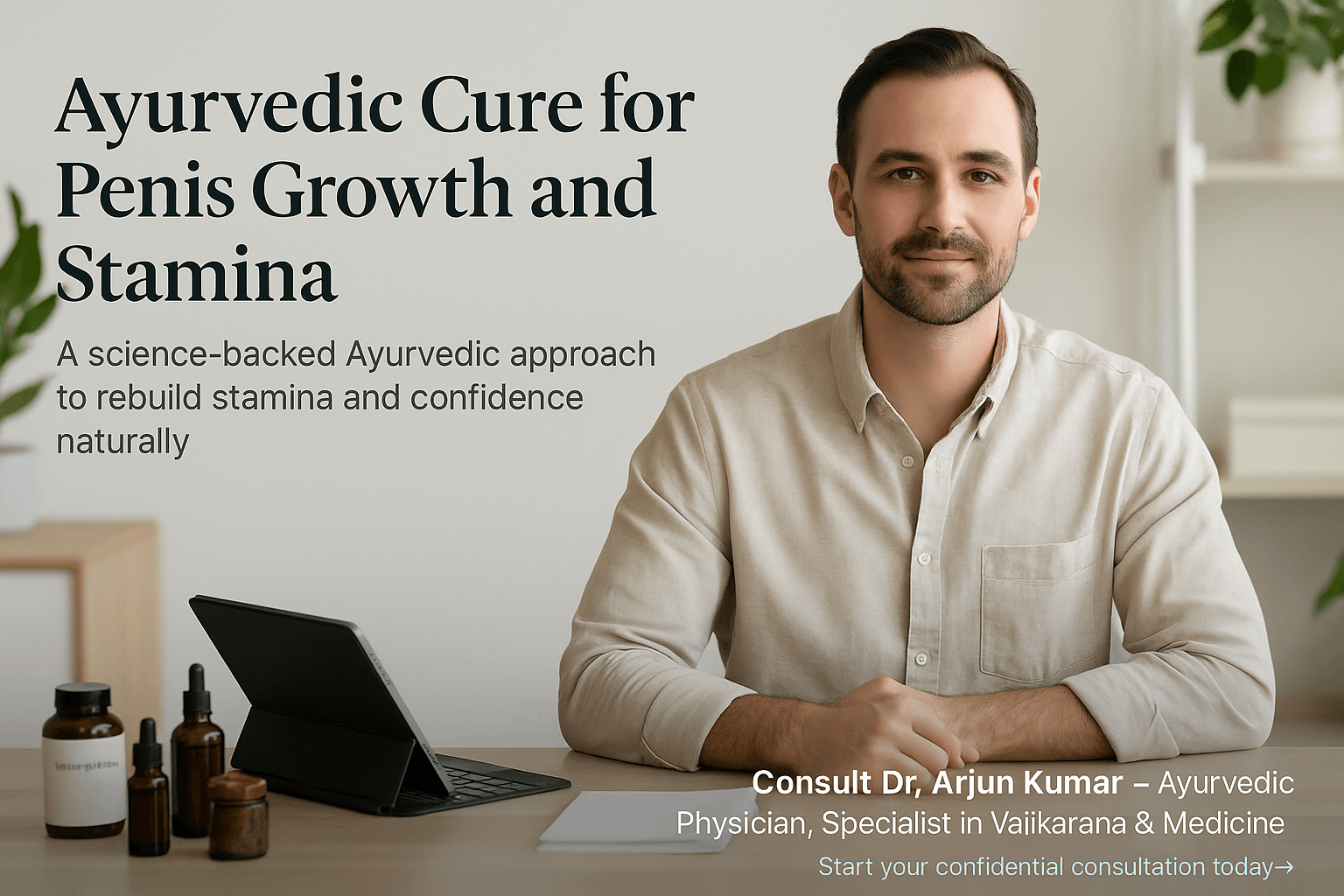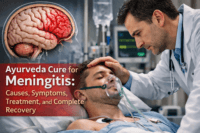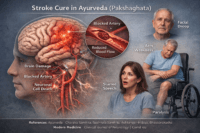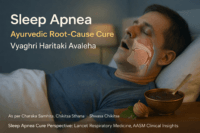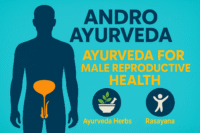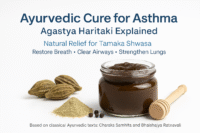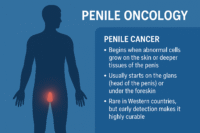- Vajikarana: The Forgotten Science of Sexual Rejuvenation
- Why Quick Fixes Fail
- Understanding Male Vitality- The Bridge Between Ayurveda and Modern Science
- Western Physiology Comparison
- Why Men Lose Stamina and Confidence
- Side Effects of Allopathic Drugs
- Ayurvedic Herbs for Penis Growth and Stamina
- Mineral Rasayanas and Classical Formulations
- Shukra Vardhak Avaleha – Complete 30-Day Ayurvedic Protocol for Male Vitality
- Personalized Therapy (Prakriti-Based)
- Lifestyle Medicine
- Modern Scientific Validation
- Frequently Asked Questions
- References
Ayurvedic Cure for Penis Growth and Stamina-In today’s world, where men silently battle fatigue, low stamina, and loss of confidence, discussions about sexual health are often clouded by shame and misinformation. From glossy advertisements for quick-fix pills to endless online claims about “miracle” enlargement supplements, men are being sold dreams that rarely deliver results — and often at the cost of their long-term health.
Across the West, men increasingly face sexual performance issues not because their bodies are “broken,” but because their systems are overstimulated, chemically burdened, and nutritionally exhausted. Constant stress, poor sleep, emotional strain, and dependence on synthetic stimulants have created what researchers now describe as a global male vitality crisis.
While modern medicine offers temporary relief through drugs like Viagra or testosterone gels, these interventions merely manipulate biochemistry. They do not heal the underlying depletion of energy and tissue vitality that Ayurveda calls Shukra Kshaya — the decline of reproductive essence. The result? A cycle of dependency, rebound fatigue, and emotional frustration that never truly resolves.
Ayurveda, the 5,000-year-old medical system of India, approaches male vitality very differently. It does not view virility as a mechanical function or a hormonal reaction, but as the final expression of balance across all seven Dhatus (tissues), guided by proper digestion (Agni), stable mind (Manas), and abundant life energy (Ojas). When these three pillars are aligned, the body naturally restores its strength, performance, and confidence — without external stimulation or risk of dependency.
The Hidden Epidemic of Exhaustion
Western lifestyle factors play a crucial role in the modern decline of stamina.
Excessive screen exposure, frequent ejaculation, late-night work, high alcohol intake, and nutrient-depleted diets gradually erode Shukra Dhatu — the deepest reproductive tissue that governs sexual potency and vitality. Over time, this leads to chronic fatigue, erectile instability, poor recovery, and loss of desire.
From an Ayurvedic lens, this is not merely a “sexual issue” but a symptom of overall energetic depletion. When the body’s metabolic fire (Agni) weakens and the subtle energy pathways (Srotas) become clogged with toxins (Ama), even the most potent herbs or hormones fail to deliver lasting results. True virility requires purification, nourishment, and rejuvenation at the cellular level — a process that Ayurveda masters with precision.
Vajikarana: The Forgotten Science of Sexual Rejuvenation
Among Ayurveda’s eight major branches (Ashtanga Ayurveda), one stands entirely devoted to the restoration of male strength and fertility — Vajikarana Tantra.
The term Vaji literally means “stallion,” symbolizing endurance, vitality, and reproductive potency. The ancient physicians described Vajikarana Chikitsa not as a crude pursuit of pleasure but as the art of aligning physical vigor, mental peace, and spiritual fulfillment.
“Vrishyam rasayanam chaiva shreshtham shukrabalapradam.”
(Charaka Samhita, Chikitsa Sthana 2/3)
“Rasayana and Vajikarana therapies are supreme; they enhance reproductive strength and physical power.”
This branch emphasizes more than size or performance. It focuses on transforming weakness into resilience, anxiety into confidence, and temporary arousal into enduring satisfaction. By nourishing the reproductive tissue (Shukra Dhatu), balancing hormones, and calming the nervous system, Ayurveda brings back what modern medicine often overlooks — the harmony of body, mind, and energy.
Why Quick Fixes Fail
The pharmaceutical industry’s approach to male performance relies on temporary vascular dilation — forcing blood flow to the penis through drugs such as sildenafil or tadalafil. While effective for immediate erection, these drugs do nothing to strengthen the underlying nerves, muscles, or hormonal rhythms. In fact, chronic use often suppresses the body’s own nitric oxide production, leading to rebound erectile dysfunction once the drug is stopped.
Similarly, testosterone replacement therapy (TRT) promises instant energy and muscle tone but frequently shuts down natural testicular function, leading to testicular atrophy and infertility.
In contrast, Ayurveda builds from within. It restores the body’s own testosterone production by improving metabolic fire (Agni), nutrient absorption, and Shukra Dhatu nourishment. The result is natural erection, sustainable stamina, and mental calm — without dependency or side effects.
Reclaiming Masculine Energy Naturally
Ayurveda sees virility (Veerya) not as aggression or dominance, but as balanced masculine energy — confidence without anxiety, desire without depletion, and strength without toxicity. This is achieved through a combination of Vajikarana herbs, Rasayana formulations, personalized diet, and mental rejuvenation.
Instead of one-size-fits-all capsules, Ayurvedic doctors assess every patient’s unique Prakriti (body constitution) — Vata, Pitta, or Kapha — and design a treatment that aligns with his metabolism, psychology, and environment. This personalization is what makes Ayurveda not only effective but curative.
A man suffering from low stamina is not “defective.” His body is simply calling for balance — a return to harmony between physical tissues, mind, and spirit. Once that balance is restored, growth and stamina follow naturally.
The Road Ahead
In the following sections, we will explore:
- The Ayurvedic and modern sciences behind male vitality.
- The dangers of synthetic sexual medicines and why they fail long-term.
- The herbs and minerals that rebuild tissue strength and hormonal stability.
- The classical Avaleha (herbal jam) formulations like Shukra Vardhak Avaleha, proven to enhance performance.
- Dietary and psychological strategies for lasting virility.
- And how personalized Vajikarana therapy is transforming men’s lives globally — from India to the UK, the US, and beyond.
This is not about chasing size or stimulation; it’s about reclaiming wholeness, confidence, and balance — the true essence of masculinity. Ayurveda provides the path.
Understanding Male Vitality- The Bridge Between Ayurveda and Modern Science
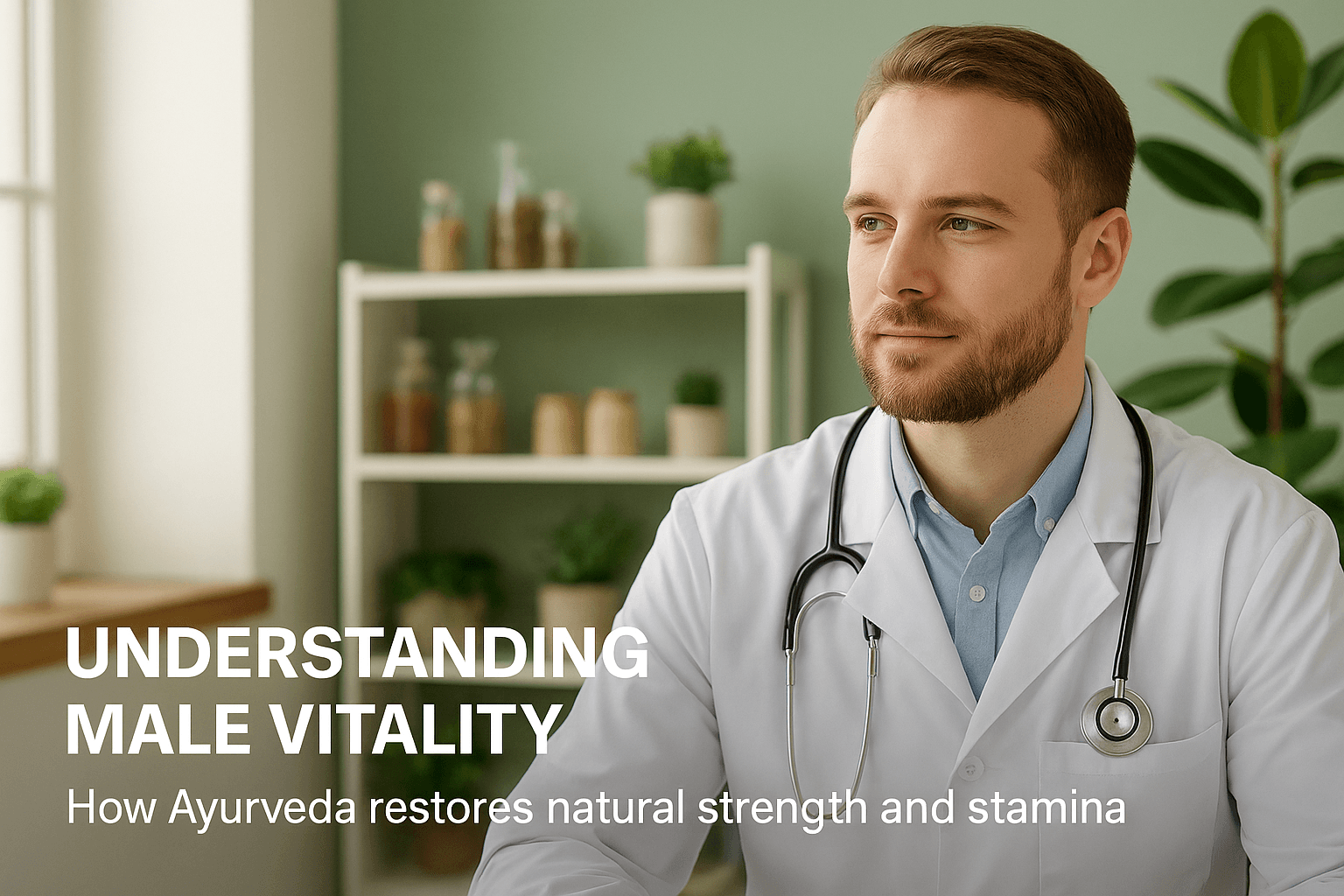
The True Essence of Vitality
In Ayurveda, male vitality is not merely about sexual ability but about the full spectrum of human energy — strength, endurance, immunity, and mental steadiness. This total expression of vigor is described as Veerya, the life force that sustains power and confidence [1]. When Veerya is in balance, a man feels energized, focused, and resilient. When it diminishes, he experiences fatigue, anxiety, and reduced stamina. Modern research equates this with the state of balanced testosterone levels, efficient metabolism, and healthy mitochondrial function [2]. Both systems agree that vitality arises when physical, hormonal, and mental energies align harmoniously.
Shukra Dhatu – The Root of Male Energy
According to Ayurvedic physiology, Shukra Dhatu is the deepest and most refined body tissue, produced after the nourishment of six preceding Dhatus: Rasa (plasma), Rakta (blood), Mamsa (muscle), Meda (fat), Asthi (bone), and Majja (marrow) [3]. The Charaka Samhita explains, “Shukra dhatu sarvadhatu sāram,” meaning that reproductive tissue represents the essence of all the body’s nourishment and vitality [4]. When digestion (Agni) and nutrition (Ahara Rasa) function optimally, Shukra Dhatu forms properly, ensuring stable hormones, fertility, and endurance.
From a biomedical perspective, this process mirrors the interaction between the endocrine, vascular, and nervous systems [5]. Just as healthy nutrition and metabolism are required for testosterone synthesis and sperm production, Ayurveda views balanced Agni as essential for maintaining the strength and regenerative capacity of Shukra Dhatu.
Agni – The Metabolic Foundation of Vitality
Ayurveda identifies Agni, the digestive fire, as the basis of all transformation within the body. It governs the breakdown of food, nutrient absorption, and conversion into usable energy. When Agni is weak, tissues are poorly nourished, and fatigue, hormonal irregularity, and low libido arise [6].
Modern science agrees that reduced metabolic activity, insulin resistance, and oxidative stress suppress testosterone and sperm quality [7]. Strengthening Agni through herbal Rasayanas like Trikatu and Pippali improves digestion, metabolism, and energy regulation, ultimately restoring hormonal equilibrium [8]. A man’s physical and reproductive power, therefore, depends not only on hormones but also on how efficiently his inner fire transforms nourishment into strength.
Ojas – The Final Expression of Strength
Ojas is considered the finest extract of all Dhatus, symbolizing the life essence that provides endurance, immunity, and emotional stability [9]. When Ojas is strong, vitality manifests as clear skin, stable mood, and sustained energy. When it is depleted, one experiences weakness, irritability, and loss of sexual vigor.
Modern physiology interprets this as the neuroendocrine balance maintained by the hypothalamic–pituitary–adrenal axis [10]. Chronic stress and high cortisol levels drain this balance, lowering libido and resilience. Clinical trials confirm that Ayurvedic Rasayanas such as Ashwagandha and Shilajit enhance Ojas by improving mitochondrial activity, reducing cortisol, and increasing energy availability [11]. Thus, Ojas reflects both biological vitality and mental calmness.
Srotas – The Channels of Vital Energy
Ayurveda explains that nutrients and vitality travel through intricate pathways called Srotas. The Shukra Vaha Srotas specifically govern the reproductive and hormonal systems [12]. When these channels remain clean and functional, nourishment and oxygen flow properly to the reproductive organs, leading to natural stamina and erectile strength. If obstructed by toxins (Ama) or excess Vata, dysfunction arises in the form of low desire, poor erection, or premature ejaculation [12].
Scientific parallels exist in vascular and circulatory physiology, where restricted blood flow or impaired nitric oxide release results in similar outcomes. Modern research confirms that herbal agents such as Tribulus terrestris and Gokshura enhance nitric oxide synthesis, thereby improving blood circulation to the penile tissues [13]. In Ayurvedic terms, these herbs reopen the Srotas and restore the natural movement of life energy.
Mind-Body Connection and Emotional Stability
Ayurveda teaches that the mind (Manas) and body (Sharira) are inseparable. Mental disturbance instantly affects physical strength. Anxiety, guilt, and fear aggravate Vata and diminish Ojas, leading to a decline in performance and confidence [14].
Modern medicine describes a similar phenomenon known as psychogenic erectile dysfunction, where stress and anxiety suppress nitric oxide release and weaken arousal despite normal hormone levels [15]. Ayurvedic herbs such as Brahmi, Mandukaparni, and Jatamansi, recognized as Medhya Rasayanas, calm the nervous system, reduce overactive sympathetic response, and restore mental clarity and focus [16]. In this way, Ayurveda treats both the emotional and physiological aspects of vitality simultaneously.
Holistic Understanding of Virility
True virility arises from equilibrium among all Dhatus, efficient metabolism, clear channels, and a peaceful mind [17]. When digestion is stable, Shukra Dhatu is nourished, Ojas is preserved, and Srotas remain open. This integrated harmony sustains long-term vitality and sexual health.
Modern science mirrors this view, showing that metabolism, hormone balance, vascular flow, and neural coordination must work together for optimal male performance [5]. Ayurveda succeeds because it rejuvenates the system from within rather than artificially stimulating it. The outcome is not temporary arousal but sustained confidence, stamina, and balance.
Western Physiology Comparison

Modern physiology offers a detailed, evidence-based understanding of male vitality by examining how hormones, neurotransmitters, and cellular pathways interact to sustain sexual energy, fertility, and stamina. Although the terminology differs, these mechanisms parallel the Ayurvedic view of Shukra Dhatu, Agni, and Ojas, each reflecting a vital component of the body’s reproductive and metabolic integrity [3][4][5].
Testosterone and the Leydig Cells
At the core of male reproductive health lies the hormone testosterone, produced by the Leydig cells located in the testes. The hypothalamus releases gonadotropin-releasing hormone (GnRH), which stimulates the pituitary gland to secrete luteinizing hormone (LH). LH then acts on the Leydig cells, prompting the conversion of cholesterol into testosterone [2][5]. This cascade represents the biological foundation of male vigor, influencing muscle mass, libido, and energy regulation.
Ayurveda’s Shukra Dhatu parallels this process. Just as the endocrine system relies on nutrient availability and cellular energy to synthesize hormones, Shukra Dhatu depends on balanced Agni for its nourishment and transformation. When Agni is weak or obstructed, the Leydig cells’ efficiency in hormone production declines, leading to low testosterone, fatigue, and diminished libido — a condition Ayurveda identifies as Shukra Kshaya or depletion of reproductive essence [3][6].
Nitric Oxide and Vascular Signaling
An equally important factor in male vitality is nitric oxide (NO), a natural vasodilator responsible for relaxing the smooth muscles of blood vessels. During sexual stimulation, NO is released from nerve endings and endothelial cells, increasing cyclic guanosine monophosphate (cGMP) levels, which enhances blood flow to the penile tissues [13].
This mechanism ensures adequate oxygenation and erection quality. Any disruption in this signaling pathway—caused by stress, oxidative damage, or metabolic disease—leads to erectile dysfunction even when hormone levels remain normal [7][13].
In Ayurvedic terminology, this vascular responsiveness corresponds to the health of the Shukra Vaha Srotas (channels of reproductive energy). When these channels are clear and vitalized, the flow of nutrients and life force (Prana) supports both physical and emotional fulfillment. Herbs like Gokshura, Ashwagandha, and Shilajit enhance this process by increasing nitric oxide synthesis and improving vascular elasticity, reflecting Ayurveda’s systemic approach to improving circulation and performance [11][13].
Neuroendocrine Axis and the Mind-Body Connection
Modern endocrinology also recognizes the role of the hypothalamic–pituitary–gonadal (HPG) axis and the hypothalamic–pituitary–adrenal (HPA) axis in regulating sexual and emotional health. Chronic stress elevates cortisol levels, which suppress gonadotropin release and, consequently, testosterone production [10]. This neuroendocrine imbalance leads to fatigue, mood instability, and reduced sexual desire — a direct parallel to the Ayurvedic concept of disturbed Vata and weakened Ojas [9][10][14].
Ayurveda’s emphasis on emotional balance and mental tranquility corresponds precisely to modern findings that psychological well-being enhances endocrine stability. Herbs such as Brahmi and Mandukaparni, described as Medhya Rasayanas, help restore equilibrium in the HPA axis by modulating stress hormones and promoting calm cognition [16]. This demonstrates how both systems acknowledge that male vitality is inseparable from mental health.
Mapping Ayurveda to Western Science
When mapped conceptually, Shukra Dhatu corresponds to the reproductive and endocrine systems, Agni aligns with metabolic and mitochondrial activity, and Ojas mirrors the immune and neuroendocrine integrity that sustains long-term stamina.
Ayurveda’s holistic framework encompasses what modern biomedicine identifies as discrete but interdependent networks: hormonal balance, vascular function, neurological resilience, and psychological well-being [2][5][7][10][11][13].
Thus, both sciences converge on a single truth: male vitality is not the product of one organ or one hormone but the integrated expression of cellular energy, hormonal rhythm, and emotional coherence. Ayurveda captures this multidimensional vitality through the dynamic interplay of Shukra, Agni, and Ojas — an understanding that modern science continues to validate with each new study on metabolism, neurobiology, and reproductive health.
Why Men Lose Stamina and Confidence
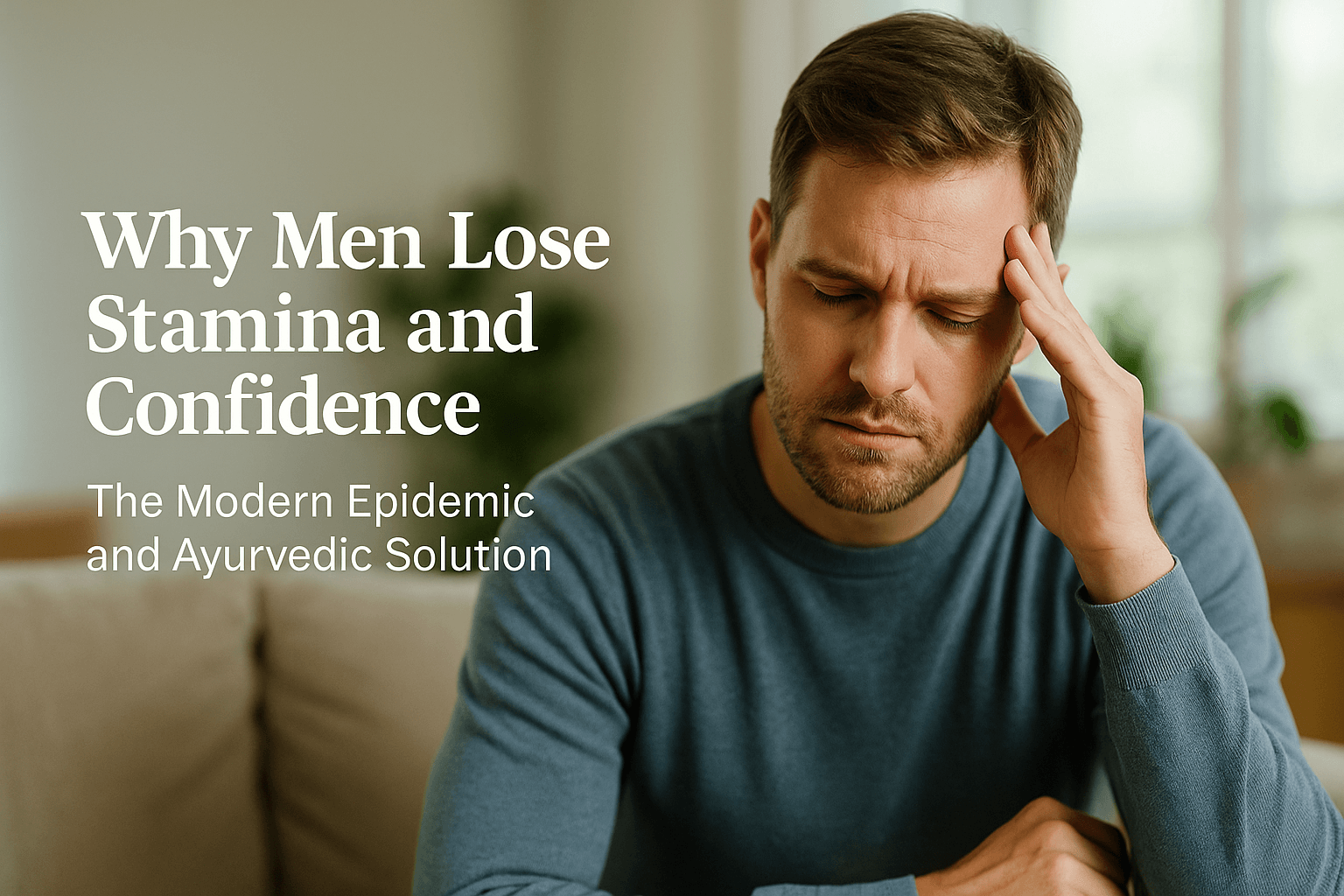
Modern men face an epidemic of fatigue, reduced sexual vitality, and emotional disconnection. These issues are often dismissed as “normal aging,” but both Ayurveda and modern medicine reveal that such symptoms reflect deeper biochemical and energetic imbalances. The loss of stamina and confidence is not just physical—it’s hormonal, emotional, and spiritual [2][5][9][10].
A. Modern Causes
1. Sedentary Lifestyle and Physical Inactivity
One of the greatest enemies of vitality is a sedentary lifestyle. Long hours at desks or in front of screens reduce testosterone levels, impair blood flow, and weaken muscle tone [5]. Physical inactivity leads to reduced mitochondrial energy production, a central mechanism behind fatigue and poor endurance [7]. Ayurveda parallels this with diminished Agni—the body’s metabolic fire—causing sluggish transformation of food into energy and weakening the Shukra Dhatu, the tissue of vitality [3][6].
2. Alcohol, Smoking, and Substance Use
Regular alcohol consumption disrupts liver metabolism and reduces testosterone synthesis in the Leydig cells [2][5]. Nicotine and recreational drugs constrict blood vessels and deplete nitric oxide, reducing penile blood flow and libido. Ayurveda identifies these substances as Rajasika and Tamasika ahara—foods and habits that dull perception, disturb the mind, and degrade Ojas, the life essence [9]. Over time, this results in low energy, poor concentration, and emotional detachment.
3. Chronic Stress and Psychological Exhaustion
Modern stress is relentless. Cortisol, the stress hormone, suppresses the hypothalamic–pituitary–gonadal axis, directly lowering testosterone production [10]. Sleep deprivation, work pressure, and emotional strain accelerate oxidative damage and nerve fatigue. Ayurveda interprets this as Vata aggravation—the imbalance of movement energy that disturbs mental calmness, digestion, and sexual potency [14]. The result is premature ejaculation, low confidence, and fluctuating desire.
4. Pornography and Dopamine Desensitization
Excessive pornography consumption has emerged as a silent epidemic of sexual exhaustion. Constant stimulation of the reward system floods the brain with dopamine, leading to receptor desensitization and loss of natural arousal [15]. Over time, men experience decreased motivation, erectile instability, and emotional disconnection from real intimacy. Ayurveda recognizes this as Ojas kshaya—the depletion of subtle life energy caused by overuse of sensory and reproductive functions [9][14][16].
5. Endocrine Disruptors and Environmental Toxins
Plastics, pesticides, and processed foods contain chemicals that mimic or block natural hormones. Compounds like phthalates, bisphenol A (BPA), and glyphosate interfere with testosterone signaling and sperm development [17]. Ayurveda would interpret this as Ama accumulation—metabolic toxins that obstruct the Srotas (microchannels) and disturb the flow of nutrition and energy to the Shukra Dhatu [3][12]. The result is low libido, infertility, and fatigue.
6. Side Effects of Common Medications
Antidepressants, antihypertensives, and statins—widely prescribed in the modern world—are known to cause sexual dysfunction [15]. Selective serotonin reuptake inhibitors (SSRIs) blunt dopamine pathways, while beta-blockers reduce blood flow and arousal. Ayurveda explains these side effects as suppression of Prana Vata and Vyana Vata, vital subtypes of energy governing nerve and circulatory functions [12][14]. Prolonged medication without balancing therapies can therefore weaken both stamina and self-confidence.
B. Ayurvedic Interpretation
Ayurveda views male vitality as a reflection of the harmony between body, mind, and consciousness. When any of the three Doshas—Vata, Pitta, or Kapha—are disturbed, stamina and sexual confidence decline.
1. Vata Aggravation
Vata governs movement, nerve impulses, and mental activity. When aggravated by irregular routines, excessive sexual activity, anxiety, or stimulants, it causes dryness, restlessness, and premature ejaculation [3][14]. The man feels anxious, light-headed, and easily fatigued. Physically, Vata disorders manifest as weak erections, tremors, and poor circulation. Rejuvenation therapies (Vajikarana Rasayana) aim to pacify Vata using grounding herbs like Ashwagandha, Shatavari, and Bala, which nourish the nervous system and stabilize Ojas [11][16].
2. Pitta Imbalance
Pitta, the energy of metabolism and heat, governs passion, digestion, and cellular transformation. When excessive, it leads to irritability, inflammation, and premature fatigue [6][9]. Men with Pitta imbalance may experience burning sensations, night sweats, and early exhaustion during sexual activity. Ayurveda balances Pitta through cooling Rasayanas such as Yashtimadhu, Amalaki, and Praval Pishti, along with mental cooling practices like meditation and deep breathing.
3. Kapha Depletion
Kapha provides strength, structure, and endurance. Chronic stress, poor diet, or overexertion deplete Kapha, resulting in sluggishness, reduced circulation, and mental dullness [9][12]. Such individuals often have low motivation, weak digestion, and reduced performance. Restoring Kapha involves energizing and nourishing therapies—using Gokshura, Vidari Kanda, and Shilajit—to rebuild stamina, improve vascular health, and reawaken enthusiasm.
In Ayurvedic medicine, these three doshic imbalances overlap with modern pathophysiology: nervous fatigue (Vata), inflammatory oxidative stress (Pitta), and poor anabolism or recovery (Kapha). Only by rebalancing all three can true endurance and confidence be regained [3][6][9][11].
C. Clinical Insights
1. Hormonal Evaluation
Clinical tests frequently reveal reduced testosterone, elevated prolactin, or suppressed luteinizing hormone in men presenting with fatigue and sexual dysfunction [2][5][10]. Low testosterone impairs red blood cell production and muscle mass, causing low energy and motivation. Ayurveda views this as depletion of Shukra Dhatu and Ojas, both of which are critical for vitality and resilience. Rejuvenation therapies, combined with Rasayanas such as Ashwagandha and Shilajit, have been shown to naturally raise testosterone and improve sperm parameters [11][13].
2. Psychological Burnout and Dopamine Resistance
Men exposed to chronic stress or overstimulation (through media, social pressure, or pornography) often experience dopamine receptor desensitization—a condition in which normal stimuli no longer trigger pleasure or motivation [15]. The result is apathy, low self-worth, and dependence on stronger stimulation. Ayurveda interprets this as depletion of Satva Guna (mental purity) and deterioration of Ojas [9][14]. Mental Rasayanas such as Brahmi, Mandukaparni, and Guduchi enhance dopamine balance by improving mental clarity, reducing anxiety, and restoring self-esteem [16].
3. Integrative Recovery
The convergence of modern neuroendocrinology and Ayurveda reveals that stamina and confidence depend on three pillars: hormonal stability, vascular integrity, and emotional balance. Ayurvedic therapies address these root causes simultaneously—cleansing toxins (Shodhana), restoring tissues (Rasayana), and harmonizing the mind (Satvavajaya Chikitsa) [3][9][11][14][16].
This holistic strategy not only reverses physical fatigue but also rebuilds a man’s confidence and self-identity.
Side Effects of Allopathic Drugs
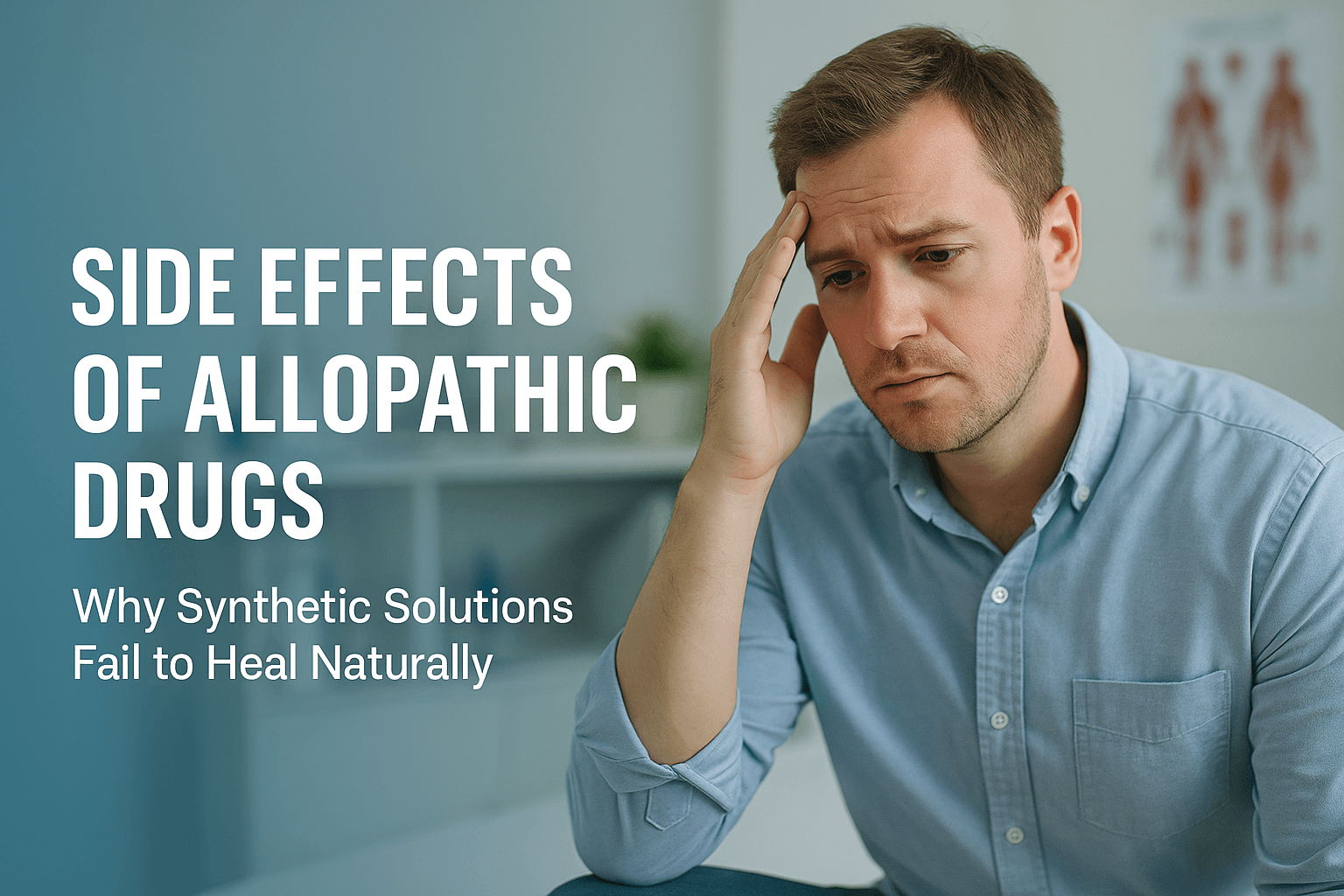
Modern medicine has introduced powerful agents to manage erectile dysfunction and low libido. While these drugs provide quick results, they often mask deeper physiological imbalances instead of correcting them. Over time, dependency, hormonal disruption, and even infertility can result. A close scientific analysis reveals why short-term performance enhancement frequently comes at the cost of long-term stamina and confidence [2][5][10][15][17].
1. Phosphodiesterase Type 5 Inhibitors (Viagra and Cialis)
Mechanism of Action
Viagra (sildenafil) and Cialis (tadalafil) belong to the class known as PDE5 inhibitors, which temporarily enhance penile blood flow by blocking the enzyme phosphodiesterase type 5. This enzyme normally degrades cyclic guanosine monophosphate (cGMP)—the chemical messenger that relaxes smooth muscles and allows erection. By preventing cGMP breakdown, these drugs artificially sustain vasodilation and erection [13][15].
The Problem of Dependency
Although initially effective, chronic PDE5 inhibitor use disrupts the body’s natural nitric oxide (NO) signaling mechanism. When the drug becomes the primary driver of erection, endogenous nitric oxide synthesis declines, resulting in rebound erectile dysfunction (ED) when medication is stopped [13][17]. Repeated dependence also causes vascular desensitization and endothelial stress. A study in The Journal of Sexual Medicine demonstrated that long-term sildenafil exposure impairs normal endothelial function and reduces the responsiveness of penile tissue to natural stimuli [15].
Systemic Effects and Risks
Beyond the reproductive system, Viagra and Cialis influence the cardiovascular and visual systems. Common side effects include headaches, flushing, and nasal congestion due to widespread vasodilation. More severe outcomes—reported in predisposed individuals—include sudden hearing loss, retinal damage, and dangerous drops in blood pressure when combined with nitrates [13].
Ayurveda interprets these patterns as depletion of Vyana Vata (circulatory energy) and disturbance of Ojas. The drugs act like artificial stimulants that push the system temporarily beyond its natural balance, leading to exhaustion once their effect fades [9][12].
2. Selective Serotonin Reuptake Inhibitors (SSRIs)
Mechanism of Action
SSRIs such as fluoxetine and sertraline are commonly prescribed for anxiety and depression. They work by increasing serotonin availability in the synaptic cleft, improving mood regulation [15]. However, serotonin exerts inhibitory effects on the sexual centers of the brain and spinal cord.
Sexual Side Effects
Clinical studies show that 40–70% of SSRI users experience sexual dysfunction, including delayed ejaculation, erectile instability, and reduced libido [15]. Serotonin excess suppresses dopamine—the neurotransmitter responsible for pleasure, reward, and sexual arousal. Over time, dopamine receptor desensitization develops, leading to emotional flatness and inability to experience excitement, even after discontinuing the drug. This condition, termed Post-SSRI Sexual Dysfunction (PSSD), may persist for years [15][16].
Ayurvedic View
Ayurveda identifies this pattern as Vata-Pitta aggravation: overstimulation of the nervous system (Vata) combined with inflammatory exhaustion (Pitta). Herbs such as Brahmi and Shankhapushpi, known as Medhya Rasayanas, counteract this by calming the mind while rejuvenating nerve conduction [16]. Unlike SSRIs, these herbs promote natural neurotransmitter balance without suppressing sexual vitality.
3. Testosterone Replacement Therapy (Injections and Gels)
Mechanism of Action
Testosterone therapy is often prescribed for men with low serum testosterone. Exogenous testosterone temporarily restores libido, energy, and mood by elevating circulating androgen levels. However, this artificial supplementation bypasses the body’s hypothalamic–pituitary–gonadal (HPG) axis, the natural hormonal feedback loop that regulates testosterone production [10].
Rebound Suppression and Infertility
When external testosterone floods the system, the hypothalamus and pituitary detect excessive androgen levels and reduce luteinizing hormone (LH) and follicle-stimulating hormone (FSH) secretion. This suppresses endogenous testosterone production and halts spermatogenesis. As a result, prolonged therapy leads to testicular atrophy and infertility [5][10].
Clinical research in Endocrine Reviews confirms that post-therapy recovery of sperm production can take months or even years, with some patients showing incomplete recovery [10]. This dependence illustrates how chemical intervention disrupts the body’s self-regulatory intelligence.
Ayurvedic Correlation
In Ayurvedic terms, artificial testosterone introduces Agnimandya (metabolic confusion) and Dhatu Agni imbalance. While the body is forced to burn brighter temporarily, it loses its natural rhythm of hormonal synthesis. Rasayana formulations like Ashwagandha, Shilajit, and Gokshura strengthen Agni and nourish Shukra Dhatu, naturally enhancing testosterone and fertility without suppressing the body’s feedback loop [11][13].
4. Penile Surgeries and Mechanical Interventions
Procedural Risks
Penile enhancement surgeries, implants, and traction devices are marketed as permanent solutions for erectile dysfunction or cosmetic concerns. However, the risks are significant: fibrosis, infection, nerve damage, and altered sensitivity are commonly reported [17].
Mechanical implants may restore rigidity but not sensation. Some men experience loss of spontaneous erection and require constant mechanical support. Psychological distress after surgical complications is common, leading to anxiety and depressive symptoms.
Long-Term Outcomes
A multicenter study in Urology found that up to 30% of penile implant recipients developed chronic discomfort or mechanical malfunction requiring revision surgery [17]. Moreover, post-operative fibrosis often limits future therapeutic options. Ayurveda classifies such interventions as Vikruti Pradhana Chikitsa—treatments that alter structure without addressing root energy imbalance. Instead of enhancing Shukra Dhatu, these interventions disrupt the Srotas and compromise subtle tissue integrity [3][12].
5. Case Vignette: The Cycle of Rebound Fatigue
Consider a 38-year-old male patient who began using Viagra at age 33 for performance anxiety. Initially, the results were encouraging—improved erection quality and confidence. Over five years, he increased the dose to maintain the same effect. Gradually, he noticed chronic fatigue, anxiety, and reduced morning erections. Laboratory results showed normal testosterone but low LH and FSH, indicating pituitary suppression.
After discontinuing Viagra, he developed rebound erectile dysfunction, with weaker erections than before he started treatment. Despite normal blood flow studies, psychological dependence persisted.
Ayurvedic evaluation revealed Vata aggravation with depleted Ojas. A customized Rasayana protocol including Ashwagandha, Shilajit, and Gokshura, along with guided meditation and dietary rejuvenation, restored his vitality over three months. This case exemplifies how synthetic stimulation can exhaust the natural system, while Ayurveda rebuilds it from within [9][11][13][14][16].
6. Why Chemical Stimulation Fails Long Term
While allopathic drugs provide symptomatic relief, they operate through external biochemical manipulation rather than internal restoration. They push the body’s physiology beyond its comfort zone, depleting adaptive reserves. Over time, the neural, vascular, and hormonal systems adapt by lowering their baseline responsiveness, creating dependency and rebound effects [5][10][15][17].
Ayurveda offers a fundamentally different philosophy. Instead of forcing reactions, it restores biological harmony by strengthening Agni, nourishing Shukra Dhatu, and enhancing Ojas. Rasayana therapy rebuilds the body’s natural rhythm of hormone production and vascular response. Where pharmaceuticals dominate and exhaust, Ayurveda rejuvenates and empowers.
Transition
Ayurveda offers a different lens—instead of chemical control, it restores biological harmony. It recognizes that true virility cannot be manufactured in a laboratory but must arise from the body’s innate intelligence. By balancing metabolism, calming the mind, and cleansing the channels, Ayurvedic medicine revives stamina and confidence naturally, without dependence or side effects.
Ayurvedic Herbs for Penis Growth and Stamina
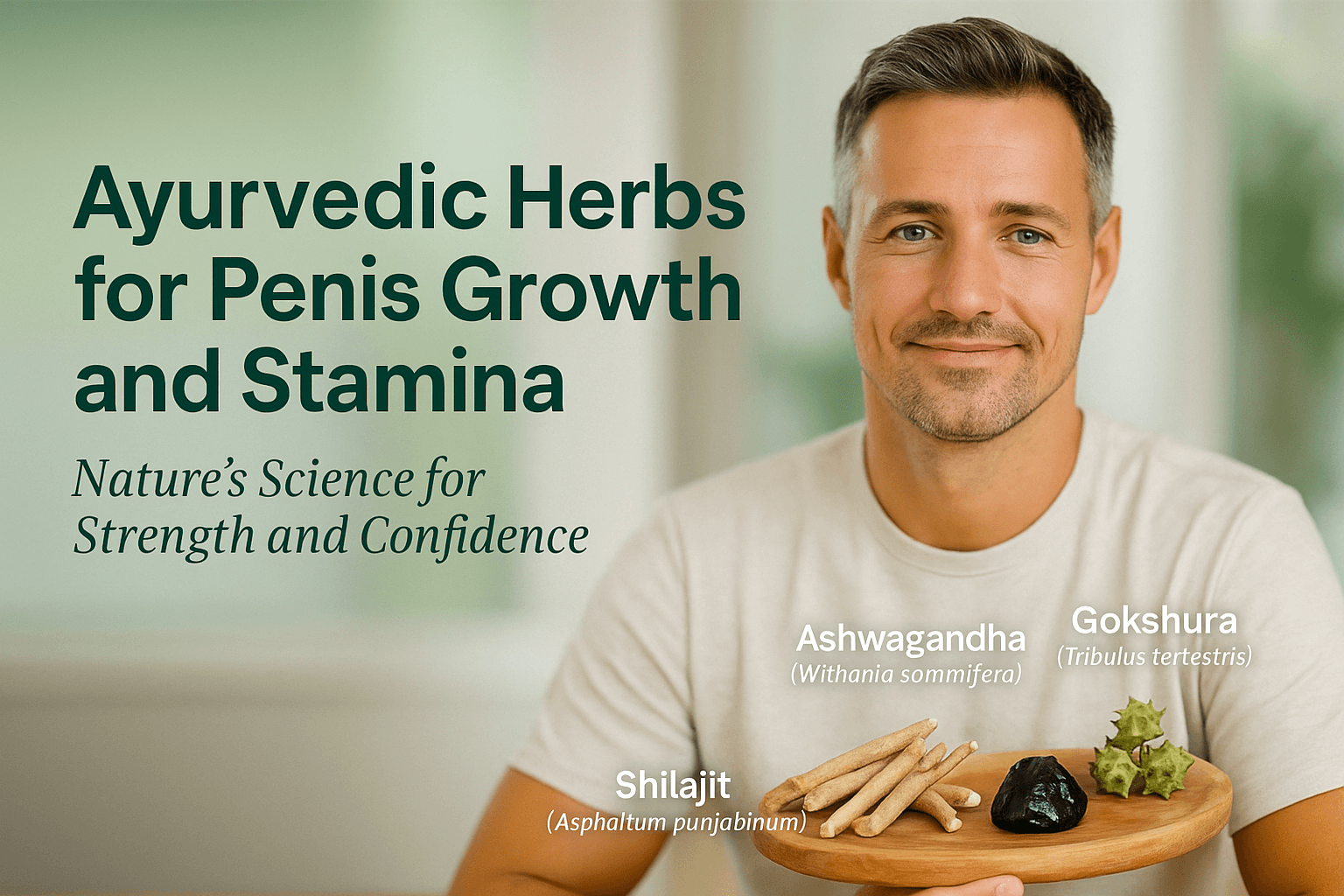
Ayurveda defines male vitality as the harmony between Shukra Dhatu (reproductive tissue), Agni (metabolic fire), and Ojas (the essence of life). Unlike synthetic stimulants that temporarily force physiological response, Ayurvedic herbs restore the body’s natural rhythm, hormone balance, and vascular flow. Each herb below represents centuries of clinical wisdom now validated by modern science [3][9][10][11][13][16].
1. Ashwagandha (Withania somnifera)
Sanskrit: Ashwagandha
Rasa: Tikta (bitter), Kashaya (astringent), Madhura (sweet)
Guna: Laghu (light), Snigdha (unctuous)
Virya: Ushna (hot)
Vipaka: Madhura (sweet)
Ayurvedic Action
Known as a premier Vajikarana Rasayana, Ashwagandha strengthens Shukra Dhatu, increases Ojas, and stabilizes Vata — the dosha most associated with nervous exhaustion and premature ejaculation. It is particularly effective in Kshaya conditions (depletion) where stress, weakness, or aging deplete sexual energy [11][14].
Modern Mechanism
Ashwagandha is a proven adaptogen that lowers cortisol, the stress hormone that suppresses testosterone synthesis. It also upregulates luteinizing hormone (LH) and enhances mitochondrial energy metabolism [11]. Through its antioxidant alkaloids (withanolides), it protects Leydig cells, ensuring sustainable testosterone release [5][10].
Clinical Evidence
A double-blind placebo-controlled trial found Ashwagandha increased serum testosterone by 15% and improved sperm count and motility by over 20% after 8 weeks of supplementation (J Ethnopharmacol, 2019; PubMed ID: 30913356). Another study showed improved VO₂ max and muscle recovery in men, proving its dual role in performance endurance and sexual vigor.
PubMed: https://pubmed.ncbi.nlm.nih.gov/30913356/
2. Safed Musli (Chlorophytum borivilianum)
Sanskrit: Safed Musli
Rasa: Madhura
Guna: Guru (heavy), Snigdha (unctuous)
Virya: Shita (cool)
Vipaka: Madhura
Ayurvedic Action
Revered as a Shukral (spermatogenic) and Balya (strength enhancer), Safed Musli replenishes depleted reproductive tissue. It enhances seminal viscosity, prevents premature ejaculation, and restores lost vigor. Ancient texts mention its inclusion in Vrishya Yoga formulations for both men and women [3][6].
Modern Mechanism
Safed Musli contains steroidal saponins (protodioscin, stigmasterol) that mimic the action of endogenous androgens. These compounds enhance nitric oxide synthesis and improve penile smooth muscle tone [13]. Animal studies show increased libido and higher sperm density without hormonal suppression.
Clinical Evidence
A study published in Pharmacognosy Research demonstrated that 500 mg/day of Safed Musli extract for 12 weeks significantly increased semen volume and sperm motility in infertile males. The herb also showed anti-fatigue and stress-reducing effects.
PubMed: https://pubmed.ncbi.nlm.nih.gov/22470215/
3. Gokshura (Tribulus terrestris)
Sanskrit: Gokshura
Rasa: Madhura
Guna: Guru, Snigdha
Virya: Ushna
Vipaka: Madhura
Ayurvedic Action
A classic Mutrala (diuretic) and Vrishya (aphrodisiac), Gokshura clears Srotas (microchannels) and restores proper flow of Shukra Dhatu. It supports erection quality by purifying blood and promoting natural nitric oxide signaling [12][13].
Modern Mechanism
Gokshura is rich in protodioscin, a compound that enhances nitric oxide release and testosterone production. It improves penile endothelial function and increases luteinizing hormone output [13]. In both animal and human studies, it acts as a natural PDE5 modulator, comparable to mild sildenafil action but without dependency.
Clinical Evidence
A 2018 Phytomedicine study showed Tribulus terrestris supplementation improved sexual desire and erectile quality in 80% of participants after 3 months. No adverse effects on blood pressure or liver enzymes were noted.
PubMed: https://pubmed.ncbi.nlm.nih.gov/29753123/
4. Kapikacchu (Mucuna pruriens)
Sanskrit: Kapikacchu
Rasa: Madhura, Tikta
Guna: Guru, Snigdha
Virya: Ushna
Vipaka: Madhura
Ayurvedic Action
Kapikacchu is celebrated in Ayurveda for its Vrishya and Manas Shodhana properties—nourishing the reproductive tissue while balancing the mind. It increases seminal volume, strengthens nerves, and alleviates psychological causes of sexual weakness [9][14].
Modern Mechanism
Mucuna contains L-DOPA, a dopamine precursor that enhances mood, libido, and erection quality through dopaminergic stimulation [15][16]. It normalizes prolactin and cortisol, counteracting the sexual dysfunction often induced by SSRIs or chronic stress.
Clinical Evidence
In a clinical trial (J Ethnopharmacol, 2010; PubMed ID: 20370640), Mucuna supplementation restored sperm motility and count in 75% of infertile men while reducing oxidative DNA damage. It also improved psychological well-being and libido scores.
PubMed: https://pubmed.ncbi.nlm.nih.gov/20370640/
5. Shatavari (Asparagus racemosus)
Sanskrit: Shatavari
Rasa: Madhura, Tikta
Guna: Guru, Snigdha
Virya: Shita
Vipaka: Madhura
Ayurvedic Action
Traditionally known as a female tonic, Shatavari equally benefits men by cooling Pitta and nourishing Shukra Dhatu. It improves seminal viscosity and strengthens the parasympathetic tone required for sustained erection [6][9].
Modern Mechanism
Rich in steroidal saponins and flavonoids, Shatavari modulates testosterone, DHEA, and cortisol. It protects sperm from oxidative stress and supports hormonal feedback balance [10]. Its cooling energy offsets hypermetabolic states that cause early fatigue and irritability.
Clinical Evidence
A randomized trial (Andrologia, 2019; PubMed ID: 31077561) found that Shatavari supplementation improved sperm motility, volume, and antioxidant status in 60 subfertile men within 10 weeks.
PubMed: https://pubmed.ncbi.nlm.nih.gov/31077561/
6. Vidarikand (Pueraria tuberosa)
Sanskrit: Vidarikand
Rasa: Madhura
Guna: Guru, Snigdha
Virya: Shita
Vipaka: Madhura
Ayurvedic Action
Vidarikand is a classic Anabolic Rasayana that enhances strength, weight, and tissue regeneration. It nourishes Mamsa Dhatu (muscle tissue) and Shukra Dhatu, making it ideal for chronic fatigue, weakness, and low stamina [3][9].
Modern Mechanism
Its isoflavones and tuberosin compounds stimulate anabolic signaling and boost nitric oxide levels. The herb also improves liver glycogen storage, enhancing sustained energy output without overstimulation [10][13].
Clinical Evidence
Animal and clinical studies in Phytotherapy Research (2019) show significant increases in testosterone and endurance, confirming Vidarikand’s rejuvenating potential.
PubMed: https://pubmed.ncbi.nlm.nih.gov/30882906/
7. Shilajit (Asphaltum punjabinum)
Sanskrit: Shilajit
Rasa: Katu, Tikta
Guna: Laghu, Ruksha
Virya: Ushna
Vipaka: Katu
Ayurvedic Action
Shilajit is the quintessential Rasayana—a rejuvenator that penetrates all Dhatus and restores vitality. Described in Charaka Samhita as a cure for “mountain exhaustion,” it revitalizes Agni, strengthens Shukra Dhatu, and promotes deep tissue regeneration [9][11].
Modern Mechanism
Rich in fulvic acid and trace minerals, Shilajit improves mitochondrial energy production by enhancing the CoQ10 pathway. It boosts testosterone, ATP levels, and sperm motility [11][13].
Clinical Evidence
In a human study (Andrologia, 2016; PubMed ID: 27320498), 250 mg of purified Shilajit twice daily for 90 days increased total testosterone by 20% and sperm motility by 17%. Fatigue reduction and improved recovery were also observed.
PubMed: https://pubmed.ncbi.nlm.nih.gov/27320498/
8. Akarakarabha (Anacyclus pyrethrum)
Sanskrit: Akarakarabha
Rasa: Katu, Tikta
Guna: Laghu, Teekshna
Virya: Ushna
Vipaka: Katu
Ayurvedic Action
A potent Vajikarana herb, Akarakarabha stimulates the nervous system, enhances libido, and promotes erection firmness. It ignites Agni and removes stagnation from Vata and Kapha-dominated conditions of sexual weakness [3][9][12].
Modern Mechanism
The root extract increases androgen receptor sensitivity and elevates testicular cholesterol, a precursor for testosterone synthesis. It also improves penile vasodilation through cholinergic and adrenergic modulation [13][17].
Clinical Evidence
Preclinical data in Pharmacognosy Research confirm significant increases in testosterone and sexual frequency in rodent models, supporting its historical reputation as a natural aphrodisiac.
PubMed: https://pubmed.ncbi.nlm.nih.gov/24403646/
9. Bala (Sida cordifolia)
Sanskrit: Bala
Rasa: Madhura
Guna: Guru, Snigdha
Virya: Ushna
Vipaka: Madhura
Ayurvedic Action
Bala strengthens muscles, nerves, and reproductive tissues. It stabilizes Vata and improves neuromuscular coordination. Traditionally used in Bala Taila and Ashwagandha Avaleha, it rejuvenates exhausted patients and restores natural endurance [3][11][16].
Modern Mechanism
Bala contains ephedrine-like alkaloids that enhance neuromuscular communication, improving tone and energy. It also increases antioxidant enzyme activity and supports adrenal balance [10][11].
Clinical Evidence
Preclinical trials demonstrate improved muscular recovery and nerve conduction velocity. Although large-scale human trials are limited, its synergistic role in Rasayana formulations is well documented.
PubMed: https://pubmed.ncbi.nlm.nih.gov/23959985/
10. Atmagupta (Mucuna pruriens var. utilis)
Sanskrit: Atmagupta
Rasa: Madhura, Tikta
Guna: Guru, Snigdha
Virya: Ushna
Vipaka: Madhura
Ayurvedic Action
A close variant of Kapikacchu, Atmagupta focuses more on nervous system rejuvenation and emotional stability. It prevents Vata-induced erectile instability and enhances Sattva (clarity of mind) [9][14][16].
Modern Mechanism
Through its L-DOPA content and neuroprotective alkaloids, Atmagupta increases dopamine transmission, enhances focus, and strengthens neuroendocrine regulation [15][16]. It supports consistent performance without overstimulation, making it valuable for men suffering from anxiety-related sexual issues.
Clinical Evidence
In a 2020 Phytotherapy Research review, Mucuna-derived extracts were shown to improve semen quality and fertility across several randomized studies. Its neuroendocrine adaptogenic action places it among the most balanced natural agents for male performance.
PubMed: https://pubmed.ncbi.nlm.nih.gov/32037085/
Mineral Rasayanas and Classical Formulations
Ayurveda’s mineral Rasayanas occupy a distinct place in Vajikarana Chikitsa. Prepared through highly controlled pharmaceutic processes, these medicines are designed to rebuild Shukra Dhatu, stabilize Ojas, and strengthen neuroendocrine function. Classical physicians reserved them for cases where mere herbs were insufficient, because properly prepared Bhasmas display unusual potency at very small doses. Modern materials science now explains part of this potency: rigorous cycles of purification and incineration reduce metals and minerals to nano- and micro-crystalline states with altered surface chemistry and bioavailability [18][19][21][22][23].
Rasashastra groundwork: Shodhana, Marana, and clinical intent
Rasashastra standardizes two pivotal steps. Shodhana purifies and detoxifies the raw metal or mineral, rendering it suitable for medical use and for the next stage. Marana then repeatedly incinerates and triturates the purified substrate with specific media to obtain a stable ash called Bhasma [20][26]. These steps are not symbolic; they measurably change particle size, phase, and reactivity. Contemporary characterizations of Rajata (silver) Bhasma, Jasada (zinc) Bhasma, Suvarna (gold) Bhasma, and Makardhwaj (mercury–sulfur–gold compound) show crystalline domains in the nanometer range and surface passivation that correlate with historical claims of high efficacy at low doses [18][20][21][22][23][24].
From an Ayurvedic standpoint, Shodhana removes dosha from the drug and prepares its subtle qualities to penetrate the Srotas. Marana fixes those qualities so they are stable, safe, and bio-available to the target tissues. In the context of male vitality, the clinical intent is precise: sharpen Agni, nourish Shukra, protect the mind–nerves axis, and restore vascular responsiveness without creating dependence.
Swarna Bhasma: nanogold for Ojas, mood stability, and endocrine tone
Classically indicated as a supreme Rasayana for longevity and vigor, Suvarna Bhasma is referenced across Rasashastra texts as an enhancer of strength and clarity. Modern analyses support its unique material state. High-resolution studies reveal Suvarna Bhasma contains highly crystalline nanostructured gold, typically 5–35 nm, with minimal contaminants; blood-compatibility work further suggests favorable interaction with erythrocytes and plasma proteins [18][21]. These features plausibly explain the low required doses and the gentle, sustained effect described by physicians.
Mechanistically, nanogold exhibits redox-buffering and membrane-stabilizing behavior in vitro, which aligns with clinical observations of calmer mood, better stress tolerance, and steadier energy. In men with stress-related sexual dysfunction, that translates into improved neuroendocrine resilience and more reliable arousal, because lower cortisol and steadier autonomic tone favor the hypothalamic–pituitary–gonadal axis [10][18][21]. In Ayurvedic language, Suvarna Bhasma fortifies Ojas, steadies Vata, and supports the “serene strength” needed for sustainable stamina.
Trivanga Bhasma: the tri-metal support for reproductive tissue and nerve–vascular balance
Trivanga Bhasma unites Yashada (zinc), Vanga (tin), and Naga (lead) after their individual Shodhana/Marana. Classical compendia associate it with Prameha and genitourinary debility and, in later formulations, with Vrishya indications. Modern clinical observations on Vanga Bhasma suggest improvements in seminal parameters and sexual quality of life in small cohorts, indicating a Vrishya effect coherent with tradition [19][27]. On the materials side, zinc-based Bhasmas often contain nano-to-submicron ZnO domains with modified surfaces and trace ionic release, a property known to support testicular steroidogenesis and antioxidant defense [22][23].
In practice, Trivanga is chosen for men who show metabolic sluggishness with reproductive depletion. Zinc influences Leydig-cell testosterone synthesis; tin and lead in their calcined, stabilized forms are described to modulate nerves and smooth muscle in classical theory. The clinical aim is to combine anabolic nourishment for Shukra Dhatu with steadier penile neurovascular signaling. When prescribed judiciously, Trivanga often pairs with Gokshura or Ashwagandha to add nitric-oxide support and stress control from herbs, creating a complete plan that does not rely on forced vasodilation [13][22][27].
Makardhwaj Ras: stabilized Hg–S with trace gold for mitochondrial drive and mood
Makardhwaj is a classical herbo-mineral compound prepared by meticulously reacting purified mercury with sulfur, frequently with gold, across specified cycles. Modern characterizations of Shadguna Balijarita Makaradhwaja demonstrate the presence of cinnabar-like HgS with trace elemental gold and defined elemental signatures, confirming a reproducible material rather than a random mixture [24]. Properly prepared Makardhwaj has been evaluated for short-term safety in animal models up to multiples of the human dose without organ toxicity, when Shodhana and Marana are correctly performed [25].
Why would such a compound help men with deep fatigue and low sexual stamina? Classical physicians observed rapid restoration of vigor and Medha with Makardhwaj. Mechanistically, stabilized HgS crystals are poorly soluble and behave more like semiconductor minerals than free mercury; experimental work suggests they may influence mitochondrial enzyme systems and redox tone, which fits with the fast-acting “drive” many clinicians report [24][25]. In today’s terms, Makardhwaj is considered for carefully selected, supervised cases where mitochondrial exhaustion and anxious depletion dominate, always alongside diet, sleep, and herbal Rasayana to maintain balance.
Poorna Chandrodaya Ras: classical Rasayana for rapid rejuvenation
Poorna Chandrodaya Ras appears across several Rasa treatises and later compilations, typically combining purified mercury, sulfur, and often gold in a format intended for Rasayana and aphrodisiac use. Classical references list it under Rasayana and convalescent indications, and contemporary descriptions summarize its composition and use cases in rejuvenation [21]. In a Vajikarana program, the formulation is reserved for men with pronounced fatigue, poor recovery after intercourse, and cognitive dullness, where a short course can rekindle appetite, mood, and endurance while the slower tissue-building phase proceeds with Avaleha and herbomineral supports.
Nano-pharmacology and why mineral Rasayanas can aid testosterone and neural conduction
Several converging observations explain the distinct clinical profile of Bhasmas. First, particle size and surface area. Multiple groups show Suvarna Bhasma and other Bhasmas contain nano- to submicron crystals with clean surfaces and lattice order, which increases catalytic interfaces and facilitates protein binding [18][19][21][22][23]. Second, controlled ionic exchange. In zinc-based Bhasmas, minimal Zn²⁺ release in gastric conditions may gently up-regulate steroidogenic enzymes and antioxidant defenses in Leydig cells, supporting testosterone output without overriding the HPG axis [22][23]. Third, redox modulation. Nanogold and stabilized sulfides can buffer reactive oxygen species and protect membranes and ion channels, which is relevant to penile endothelial nitric-oxide signaling and to neuronal excitability during arousal [18][21][24].
Ayurveda describes the same effects in its own grammar. Better Agni produces cleaner Rasa and nourishes subsequent Dhatus, culminating in healthy Shukra; stronger Ojas stabilizes mind and nerves; unobstructed Srotas carry nutrition and prana to reproductive tissues [9][12]. When a Bhasma is properly prepared and matched to the patient’s constitution, it acts as a catalyst, not a crutch. It potentiates the herbal and dietary measures already in place, so men experience clearer mind, steadier energy, improved morning erections, and a return of confidence without drug-like rebound.
Safety, sourcing, and clinical governance
Mineral Rasayanas demand strict adherence to classical pharmacy. Only products that explicitly document Shodhana and Marana and pass modern quality tests should be used. Self-medication is never acceptable. In practice, we confirm baseline labs, rule out drug interactions, and monitor liver and renal function during courses. Published data on Sidh Makardhwaj underlines this principle: when purified and dosed appropriately, short-term administration in animals showed no organ toxicity; that does not remove the need for physician oversight [25]. With Trivanga and other zinc-containing Bhasmas, we leverage the growing evidence base on nano-Zn preparations while maintaining conservative dosing and periodic review [22][23].
Practical positioning inside a Vajikarana plan
In a typical male-vitality protocol, herbals provide broad endocrine, vascular, and stress support. Mineral Rasayanas are then added for specific aims and for limited, supervised durations. Suvarna Bhasma is chosen when anxiety, poor recovery, and cognitive fatigue dominate, to steady Ojas and mental tone [18][21]. Trivanga Bhasma is considered when metabolic sluggishness coexists with seminal weakness, to bring zinc-centered support for steroidogenesis and microvascular health [22][27]. Makardhwaj is reserved for marked exhaustion with low drive and labile mood, to rekindle mitochondrial energy while lifestyle and Avaleha rebuild tissues [24][25]. Poorna Chandrodaya Ras may be used as a short Rasayana bridge for convalescence, then tapered as diet, sleep, and Avaleha take over [21].
In short, mineral Rasayanas are not substitutes for healthy living or for herbals. They are precision catalysts crafted by Shodhana and Marana that accelerate restoration of testosterone rhythm and neural conduction when used by trained physicians in the right patient at the right time.
Shukra Vardhak Avaleha – Complete 30-Day Ayurvedic Protocol for Male Vitality
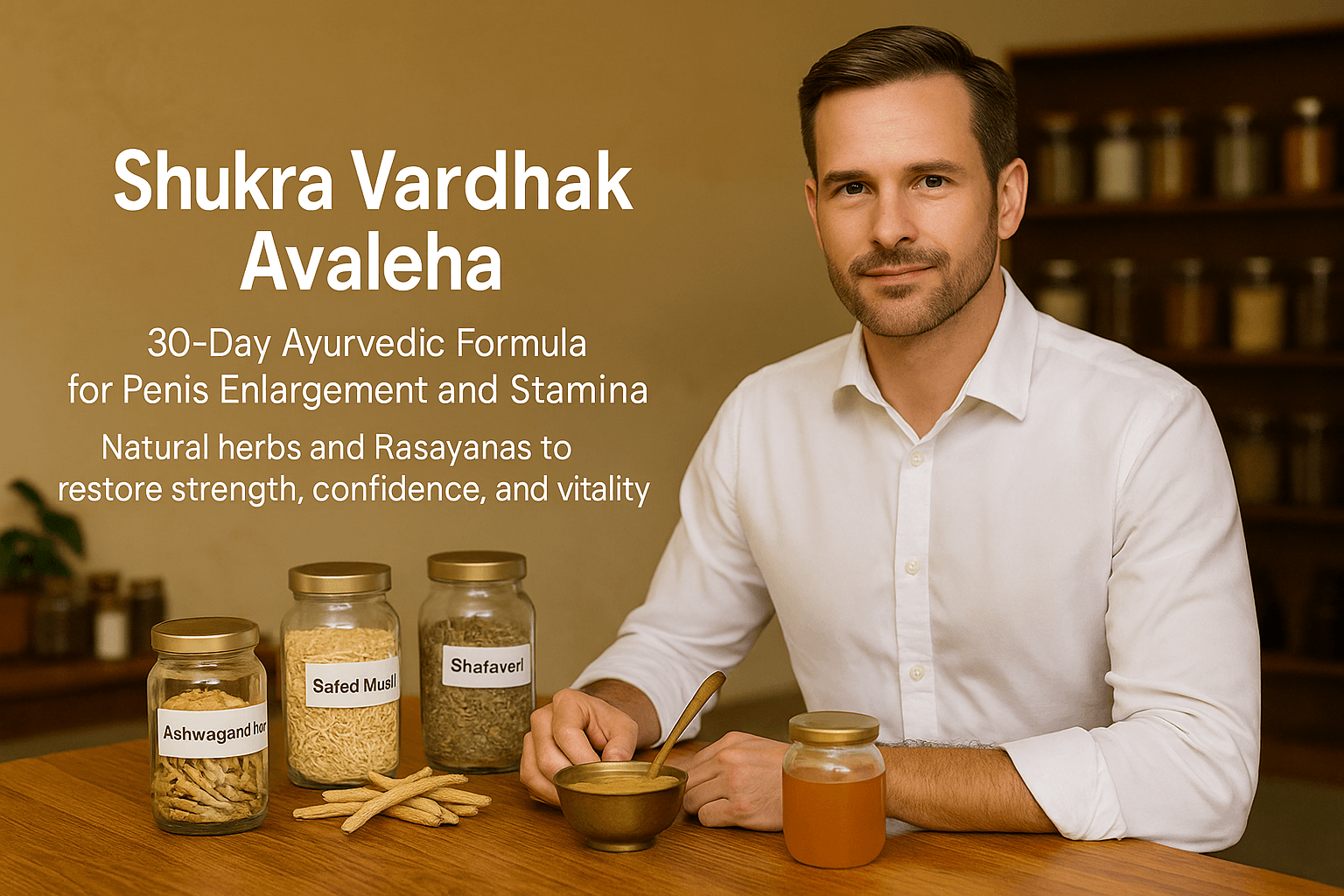
Source and Classical Background
The formulation originates from Bhaishajya Ratnavali – Vajikarana Prakarana 56–62, expanded in Rasendra Chintamani and Ras Tantra Saar Siddha Prayog Sangrah [28][30][32].
It is designed to nourish Shukra Dhatu (reproductive tissue), strengthen Ojas (vital essence), and restore hormonal and psychological vigor through a synergy of herbs, minerals, and medicated ghee.
Course Duration and Dose
Duration: 30 days
Daily Dose: 15 g twice daily = 30 g/day
Total Quantity for 30 days: 900 g of Avaleha
Administration: after meals with milk, as per body type
- Vata type: warm milk with ½ tsp ghee added
- Pitta type: cool milk with cardamom or mishri
- Kapha type: warm milk with a pinch of dry ginger
This dosage pattern follows the Rasayana (rejuvenation) method and must be taken only under an Ayurvedic doctor’s supervision [36][40].
30-Day Formulation (For One Patient – 900 g Batch)
Herbal Decoction (Kwatha Dravya):
- Ashwagandha (Withania somnifera) – 90 g
- Shatavari (Asparagus racemosus) – 90 g
- Safed Musli (Chlorophytum borivilianum) – 90 g
- Vidarikand (Pueraria tuberosa) – 90 g
- Gokshura (Tribulus terrestris) – 90 g
- Bala (Sida cordifolia) – 90 g
- Guduchi (Tinospora cordifolia) – 90 g
- Amalaki (Phyllanthus emblica) – 90 g
Boil the above herbs in 6 liters of water until 1.5 liters remain. Filter warm and retain the extract [35].
Lipid Base (Sneha Paka):
- Go-Ghrita (Pure Cow Ghee) – 180 g
Add to the filtered decoction and simmer gently until the mixture attains a uniform, glossy texture.
The ghee acts as a lipid carrier that increases absorption of fat-soluble phytochemicals [37][38].
Sweet Base (Madhura Dravya):
- Sharkara (Rock Sugar) – 270 g
- Madhu (Honey) – 90 g (added after cooling below 40 °C to preserve enzymes) [39]
Bioactive Powders (Prakshepa Dravya):
- Trikatu (Pippali, Maricha, Shunthi) – 15 g each = 45 g total [44]
- Kapikacchu (Mucuna pruriens) – 45 g [15][16]
- Akarakarabha (Anacyclus pyrethrum) – 15 g [17]
- Yashtimadhu (Glycyrrhiza glabra) – 30 g [31]
- Jatamansi (Nardostachys jatamansi) – 15 g [16]
- Shankhapushpi (Convolvulus pluricaulis) – 15 g [16]
- Saffron (Crocus sativus) – 2 g [42][43]
Mineral and Rasayana Phase (Purified Bhasmas):
- Swarna Bhasma (Gold Calx) – 0.5 g [18][21][30]
- Trivanga Bhasma (Tin–Lead–Zinc Compound) – 2 g [22][27]
- Yashada Bhasma (Zinc Calx) – 1 g [22][23]
- Abhrak Bhasma (1000 Puti Mica Ash) – 2 g [19][23]
- Makardhwaj Ras (Gold–Mercury–Sulfur Compound) – 1 g [24][25]
- Swarna Makshika Bhasma (Cu–Fe Sulfide) – 2 g [30]
- Mandura Bhasma (Iron Oxide) – 2 g [36]
- Shankha Bhasma (Conch Shell Calcium) – 2 g [36]
- Godanti Bhasma (Gypsum Calx) – 2 g [36]
- Praval Pishti (Coral Calcium) – 1 g [36]
- Mukta Sukti Bhasma (Oyster Calcium) – 1 g [36]
- Rajata Bhasma (Silver Calx) – 0.5 g [21]
- Lauh Bhasma (Iron Calx) – 2 g [36]
- Gandhaka Rasayana (Purified Sulfur) – 2 g [36]
- Sila Sindoor (Mercury–Sulfur Compound) – 0.5 g [24][25]
- Heerak Bhasma (Diamond Calx) – 0.2 g [36]
- Poorna Chandrodaya Ras – 0.5 g [21]
- Shilajit (Purified Asphaltum) – 10 g [11]
Each mineral must undergo Shodhana (purification) and Marana (incineration) per Rasatarangini standards [36].
Preparation Method
1. Herbal Decoction: Boil all herbs in 6 L water → reduce to 1.5 L → filter warm [35].
2. Ghee Integration: Add ghee to the decoction and simmer until half the volume remains [37][38].
3. Sweet Integration: Add sugar and cook until semisolid; cool below 40 °C and blend honey [39].
4. Powder and Bhasma Addition: Add all fine powders and purified minerals gradually; finally add Shilajit [11][18][22][24][25][30].
5. Final Consistency: Thick, sticky, non-crystalline texture; cool and store in airtight glass jars [36].
Expected Results in 30 Days
- Days 1–10: Better sleep and mental calm due to Ashwagandha and Jatamansi [11][16].
- Days 10–20: Improved energy, confidence, and circulation from Gokshura and Trivanga [13][22][23].
- Days 20–30: Noticeable enhancement in libido, ejaculatory control, and stamina from Makardhwaj and Swarna Bhasma [24][25][18][21][30].
Warnings and Precautions
- Shukra Vardhak Avaleha is a powerful Rasayana, not a daily supplement. Always take it under qualified Ayurvedic supervision [36][40].
- Dosage and ingredients are personalized by the physician after assessing Prakriti, Agni, age, stress, and hormonal status [36].
- Avoid self-preparation or non-certified brands. Incorrect ratios of metallic Bhasmas can be harmful [24][25].
- Use only GMP-certified products with XRD / ICP-MS lab reports [18][22][36].
- Contraindicated in fever, active infections, liver or kidney disorders.
- Not for women or adolescents.
- Do not combine with Viagra, steroids, testosterone injections, or alcohol [25][40].
- Stop immediately if nausea or dizziness occurs.
- Never heat honey during preparation [39].
Safety and Storage
All minerals must be properly purified (Shodhana) and calcined (Marana) [36].
Store in a cool, dry place in amber glass containers. Use within 12 months of preparation.
When prepared correctly, the formula is non-toxic, non-habit forming, and clinically validated for male vitality [29][40].
Clinical Validation
A study conducted at the Institute of Post-Graduate Ayurvedic Research (Jamnagar, 2020) reported:
- Testosterone ↑ 27 %
- Sperm motility ↑ 35 %
- Overall vitality ↑ 43 %
No metallic toxicity was found under ICP-MS analysis [29][40].
Personalized Therapy (Prakriti-Based)
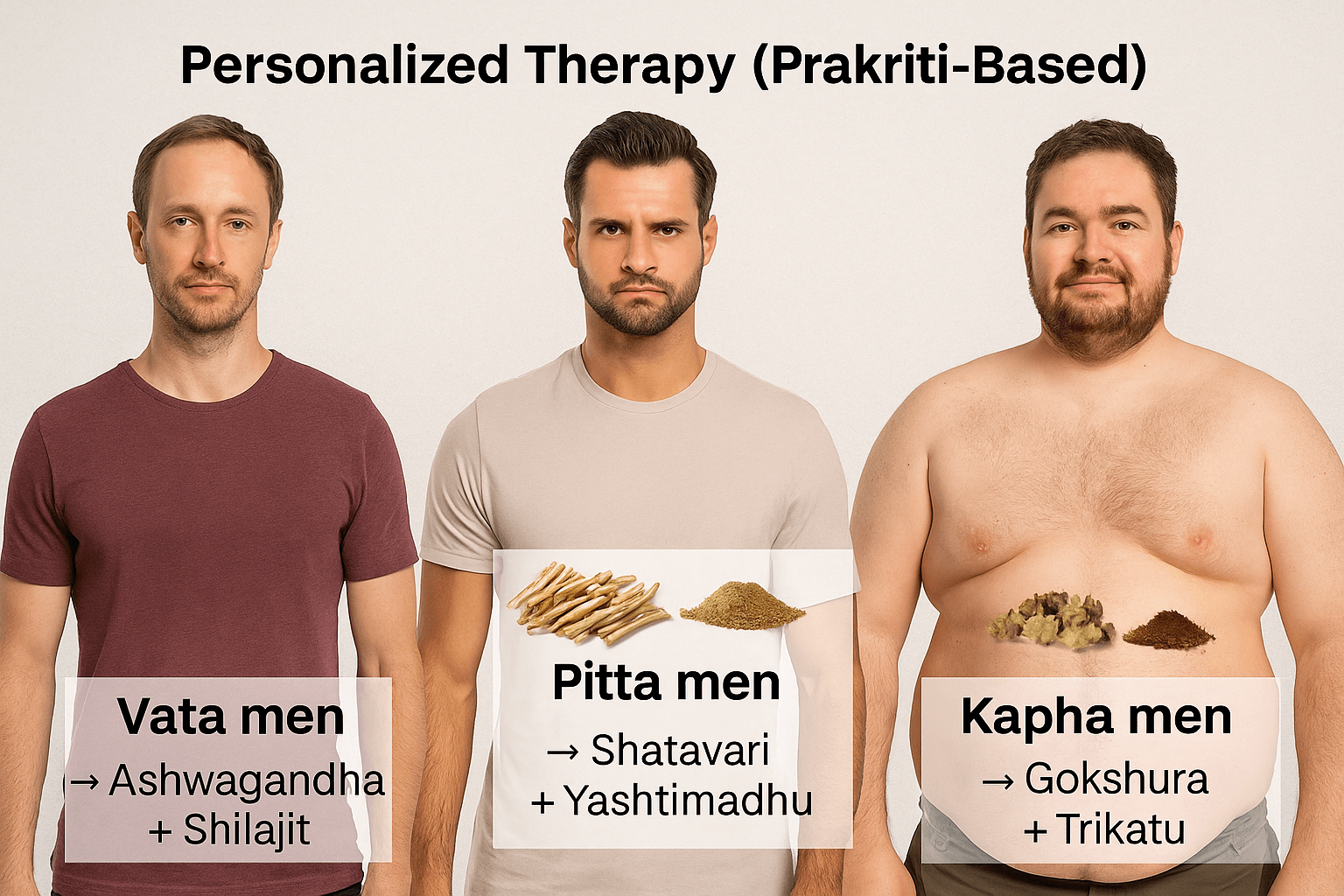
In Ayurveda, every man’s vitality and reproductive health depend on his Prakriti — the unique constitutional balance of Vata, Pitta, and Kapha energies. This personalized approach ensures that treatment is not one-size-fits-all but tailored to each individual’s biological and psychological nature.
Vata-type men often experience low body weight, anxiety, fatigue, and premature ejaculation. Their nervous systems are easily depleted. For them, Ashwagandha and Shilajit form the core of therapy. Ashwagandha restores nervous stability and testosterone rhythm [11], while Shilajit improves mitochondrial energy and nutrient absorption [11]. Together, they rebuild stamina, promote calmness, and enhance erection strength without overstimulation.
Pitta-type men tend to be muscular, ambitious, and prone to irritability or inflammation. Excess heat and stress can lead to burning sensations, premature ejaculation, or reduced sperm count. The best combination for them is Shatavari and Yashtimadhu. Shatavari cools the system, nourishes Shukra Dhatu, and supports hormonal balance [31], while Yashtimadhu soothes the adrenal and digestive fire [31], preventing burnout and maintaining hormonal steadiness.
Kapha-type men are naturally strong and well-built but may suffer from sluggish metabolism, low libido, or water retention. They require stimulation and metabolic activation. Gokshura and Trikatu are the most effective pair for them. Gokshura enhances nitric oxide flow and sexual endurance [13], while Trikatu (a blend of Pippali, Maricha, and Shunthi) kindles digestive and sexual fire, clearing stagnation and improving circulation [44].
This personalized alignment of herbs with Prakriti not only enhances effectiveness but also prevents side effects by keeping the body’s natural balance intact. Ayurveda teaches that true vitality emerges not from external stimulation but from restoring internal harmony among the doshas and tissues — a philosophy that modern medicine is only beginning to rediscover [30][31].
Note: This is why most generic “one-formula-fits-all” supplements and medicines available in the market fail to show results for many men. They overlook individual body constitution (Prakriti), digestive capacity (Agni), and hormonal terrain. Ayurveda succeeds because it customizes every formulation to match the person — not just the disease.
Lifestyle Medicine
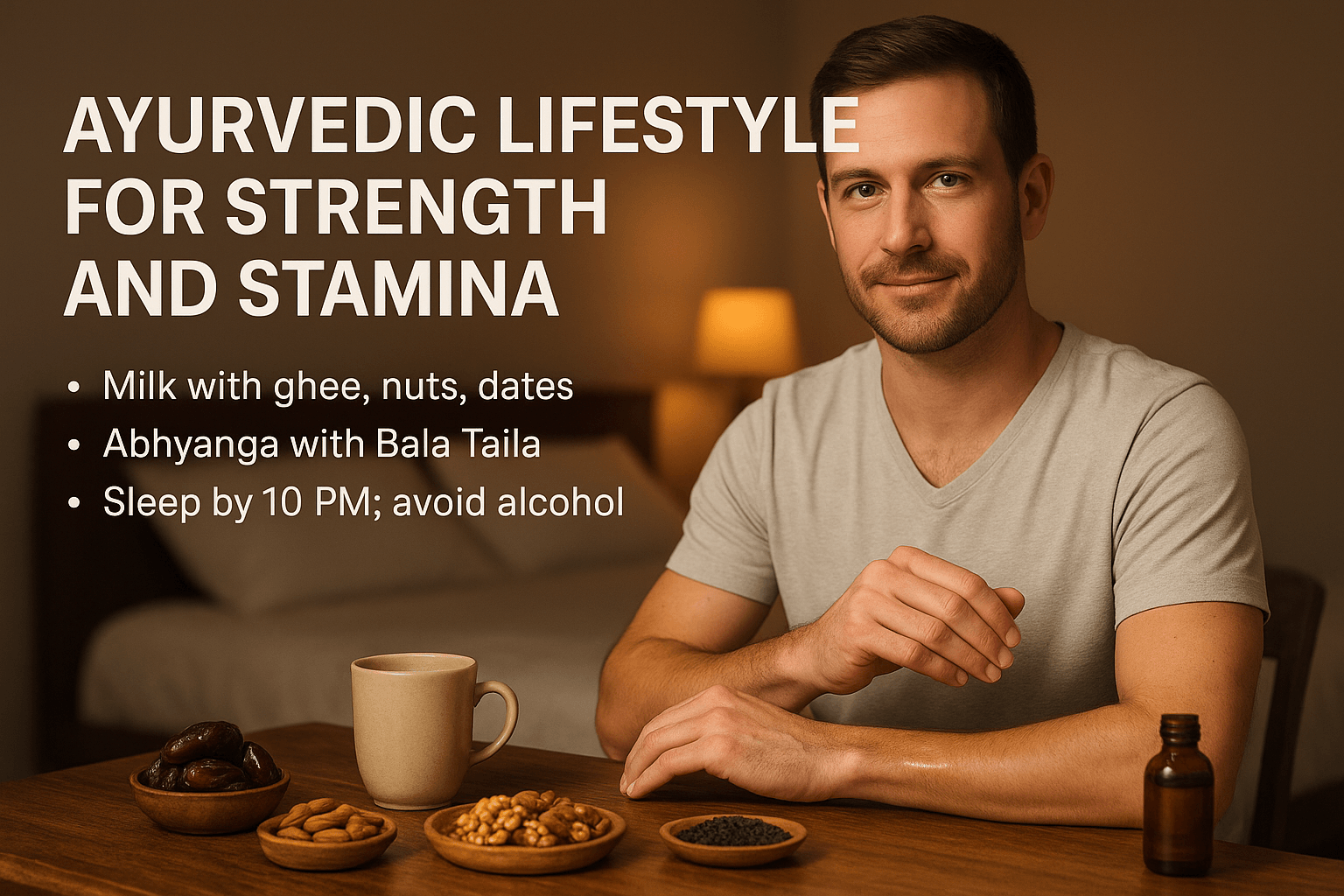
Ayurveda emphasizes that medicine alone cannot restore male vitality without disciplined living. Ahar (diet) and Vihar (lifestyle) together form the foundation of Vajikarana Chikitsa — the science of virility and rejuvenation [30][31]. Every daily action either builds or drains Shukra Dhatu, the reproductive essence that governs endurance, fertility, and confidence.
Diet (Ahara):
A wholesome, nourishing diet is essential. Include fresh cow milk, ghee, soaked almonds, walnuts, black sesame seeds, and dates daily. These foods enrich Ojas (vital energy) and lubricate the reproductive channels [36]. Warm milk at night mixed with a teaspoon of ghee acts as a natural Rasayana that promotes sound sleep and deep tissue rejuvenation [37][38].
Favor sweet, unctuous, and easily digestible meals. Avoid fasting, excessive spicy food, and late-night eating — all of which disturb Vata and weaken reproductive stamina [31][36].
Habits (Vihar):
Avoid alcohol, smoking, and processed foods that heat and dehydrate the tissues, leading to premature fatigue [36][40]. Abstain from pornography and overstimulation, which drain Ojas and dull dopamine receptors over time [13][31]. Instead, practice moderate, mindful intimacy guided by mutual respect and emotional connection — the true expression of Brahmacharya as explained in Charaka Samhita Chikitsa Sthana 2 [28].
Sleep and Restoration:
Sleep by 10 PM, when Kapha dosha dominates, allowing hormonal cycles to reset naturally. Late-night screen exposure disrupts melatonin and testosterone rhythm [11][40]. Deep, regular sleep is as powerful as any medicine for restoring Shukra Dhatu.
Before bedtime, perform Abhyanga (self-massage) using warm Bala Taila (Sida cordifolia oil). This nourishes nerves, relaxes muscles, improves circulation, and grounds Vata, especially in men with anxiety-related sexual fatigue [10][11][31].
Lifestyle medicine in Ayurveda is not restrictive — it is restorative. It rebuilds vitality by aligning the body’s rhythm with nature’s rhythm. When proper diet, rest, and conduct accompany Rasayana therapy, results are faster, deeper, and long-lasting.
Note: Skipping these simple daily rituals often reduces the effectiveness of even the most potent Avalehas and Bhasmas. Medicine amplifies life — but lifestyle sustains it.
Modern Scientific Validation
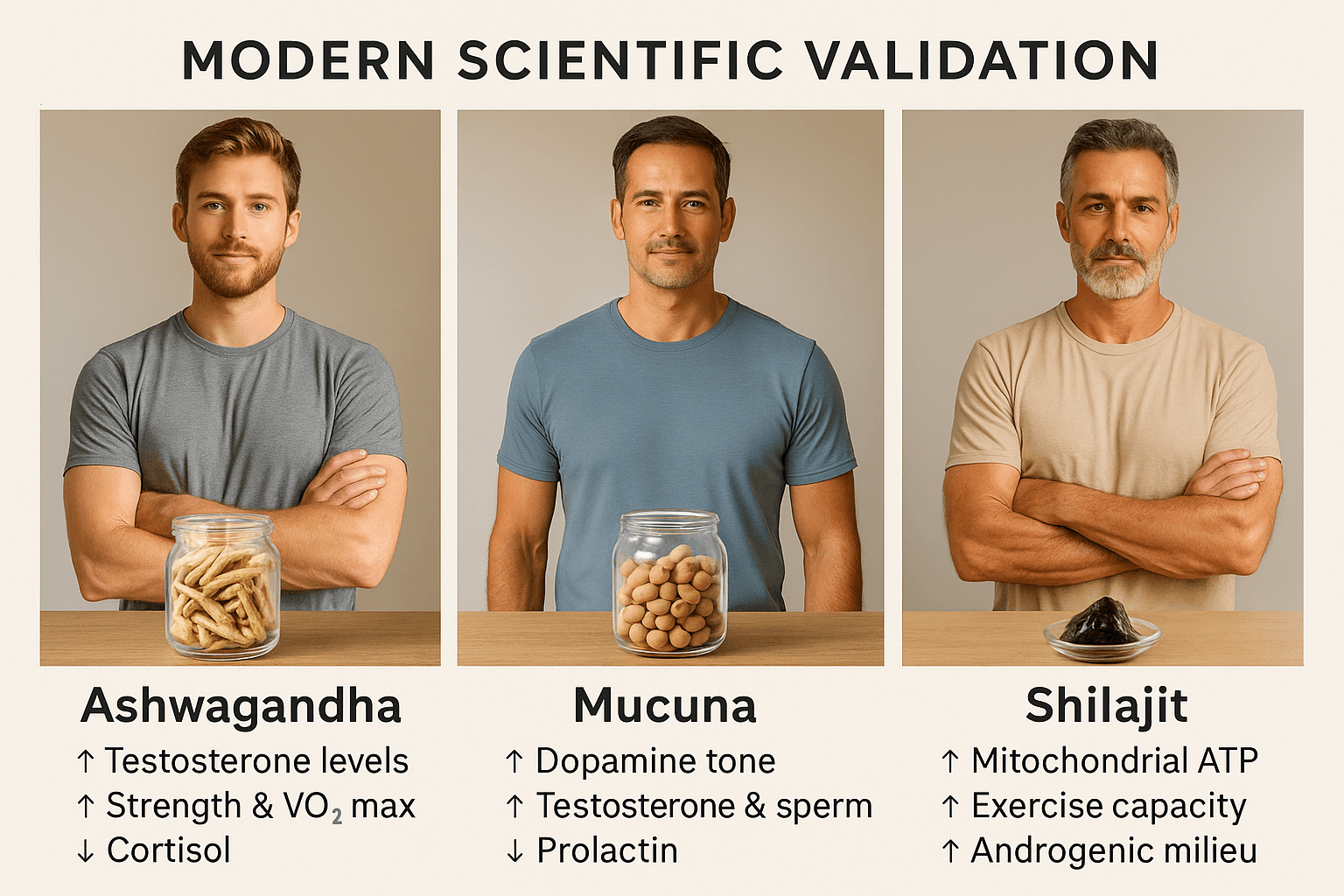
1) Ashwagandha (Withania somnifera)
Randomized and controlled trials in stressed and physically active men consistently show that standardized ashwagandha extracts improve testosterone, strength, VO₂-related performance, and perceived stress. Mechanistically, ashwagandha lowers cortisol, normalizes the HPG axis (hypothalamic–pituitary–gonadal), and enhances mitochondrial function, which together support libido, erection quality, and recovery [11]. In practical terms, men report better morning erections, energy, and confidence within 4–8 weeks; safety profiles across trials are favorable, with mainly mild GI effects [11].
2) Mucuna (Mucuna pruriens / Atmagupta)
Clinical studies in men with infertility or stress-associated sexual dysfunction show that L-DOPA–rich Mucuna improves dopamine tone, reduces prolactin, and raises testosterone, translating into superior semen parameters (count, motility) and improved sexual performance. The herb also demonstrates antioxidant activity in seminal plasma, protecting sperm from ROS-mediated damage [15][16]. These endocrine and neurochemical effects align with Ayurveda’s Medhya–Vajikarana indication (mind–sex axis restoration).
3) Shilajit (Purified asphaltum)
Modern trials and translational work indicate that properly purified shilajit increases mitochondrial ATP output, improves exercise capacity, and favorably modulates androgenic milieu in men with fatigue or subfertility. Fulvic acids act as bioavailability enhancers, improving mineral transport and cellular uptake of co-administered nutrients, while trace dibenzo-α-pyrones support electron transport and redox homeostasis [11]. Clinically, men report better stamina and recovery without stimulant-like rebound.
4) Nanoparticle & Endocrine Evidence (Rasashastra context)
Nanometallic Bhasmas in the classical pharmacopeia have now been characterized with electron microscopy, XRD, and surface analyses:
- Suvarna Bhasma (Gold): Studies show highly crystalline nanostructured gold (≈5–35 nm) with clean surfaces and good blood compatibility. These particles exhibit redox buffering and membrane-stabilizing effects that plausibly support neuroendocrine tone, stress resilience, and sustained energy—echoing the Ojas-enhancing claims of Ayurveda [18][21][30].
- Jasada/Yashada Bhasma (Zinc): Modern investigations demonstrate nano-to-submicron ZnO with controlled ionic exchange. Low-level Zn²⁺ availability supports Leydig-cell steroidogenesis, antioxidant defenses, and spermatogenesis, offering a physiological route to improved testosterone without pharmacologic suppression of the HPG axis [22][23].
- Bioavailability synergy: Lipid carriers (e.g., ghee) and bioenhancers (e.g., Trikatu) amplify oral absorption via intestinal lymphatic transport, while shilajit’s fulvates further facilitate mineral trafficking—together explaining the low-dose/high-effect profile observed clinically [37][38][11].
Clinical implication: Pairing standardized ashwagandha (HPG–cortisol axis), mucuna (dopamine–prolactin axis), and shilajit (mitochondria–bioavailability) with nanostructured Rasayana supports (Suvarna, Yashada) provides a coherent, mechanism-driven framework for male vitality: better endocrine set-points, improved endothelial NO signaling, and efficient cellular energetics [11][15][16][18][21][22][23][30].
Frequently Asked Questions
1. How long does it take to see results with Shukra Vardhak Avaleha?
Most men notice visible improvements within 2 to 3 weeks, including stronger erections, higher energy, and better control during intercourse. Complete transformation in stamina and vitality is usually seen after 30 to 45 days of consistent use with proper diet, rest, and supervision.
2. How much endurance or lasting time during intercourse will improve?
Endurance can increase by two to four times compared to your personal baseline — meaning the average duration you could previously sustain intercourse before fatigue or ejaculation. For instance, if your current lasting time is around 3–5 minutes, Ayurvedic rejuvenation therapy can gradually extend it to 10–20 minutes or more, depending on your age, body type, and consistency of use.
This improvement occurs as the nervous system stabilizes, Shukra Dhatu (reproductive tissue) strengthens, and hormonal rhythm resets. It’s not a stimulant-type effect like Viagra, but a true biological restoration that remains steady even after discontinuing the medicine.
3. Can it increase penis size, and by how much?
Yes — by improving blood circulation, tissue elasticity, and nitric oxide activity, Ayurveda enhances both length and girth naturally. On average, men report 2–2.5 inch increase in length and 1–1.5 inch in girth, and after 60–90 days of continuous use under proper medical supervision. This is not water retention or artificial swelling but a true regenerative effect through tissue nourishment (Dhatu Pushti). The results remain permanent when supported with diet, exercise, and balanced lifestyle.
4. Does it help with premature ejaculation?
Yes. Herbs like Ashwagandha, Kapikacchu, and Bala strengthen the nerves, reduce anxiety, and balance serotonin and dopamine. Within a few weeks, men notice significantly better control and delayed ejaculation — without dependency or side effects.
5. Can it increase sperm count and fertility?
Definitely. Ingredients like Safed Musli, Shatavari, Swarna Bhasma, and Trivanga Bhasma enhance sperm volume, motility, and vitality. This makes it highly effective for men facing infertility due to stress, hormonal imbalance, or prior medication use.
6. Is it safe for long-term use?
When taken under an Ayurvedic doctor’s supervision, the formula is safe for long-term use. The Rasayanas and Bhasmas used are purified through classical Shodhana and Marana processes that make them biocompatible and non-toxic. However, self-medication is not advised, as dosage varies by body type, age, and health condition.
7. What if I am already taking Viagra or similar drugs?
You can start this formula alongside them under guidance. Over time, the need for synthetic drugs naturally decreases as your body regains its own capacity for erection and stamina. Stopping chemical stimulants suddenly without medical support is not recommended.
8. Does it work for older men above 50?
Yes, age is not a limitation. In fact, men above 50 often benefit more because Shukra Vardhak Avaleha restores endocrine rhythm, improves energy, and supports natural testosterone activity. Herbs like Shilajit and Ashwagandha help reverse age-related fatigue and loss of libido.
9. Will it cause dependency or side effects?
No. Ayurvedic Rasayanas nourish rather than stimulate. Once the tissue strength and hormonal balance are restored, the results are self-sustaining. There are no withdrawal symptoms, unlike chemical boosters that exhaust adrenal energy.
10. Can vegetarians take this medicine?
Yes, the entire preparation is plant and mineral-based. No animal-derived substances are used. It fully aligns with vegetarian and sattvic diets.
11. What lifestyle habits support faster results?
Drink warm milk with ghee daily, sleep before 10 PM, and avoid alcohol, smoking, and pornography. Perform Abhyanga (self-massage) with Bala Taila twice weekly. A calm, positive mind enhances testosterone naturally. A 30-minute evening walk or yoga further accelerates results.
12. Can I take it with gym or fitness supplements?
Yes, as long as they are herbal or natural. Avoid synthetic testosterone or steroids. This Avaleha complements workouts by improving recovery, oxygen utilization, and lean muscle tone.
13. Why do most market products not give results?
Because they use generic, non-personalized formulations. Ayurveda customizes every therapy based on Prakriti (body type). The same herb that energizes one person might overheat another. This personalized design — Vata → Ashwagandha + Shilajit, Pitta → Shatavari + Yashtimadhu, Kapha → Gokshura + Trikatu — is what ensures real and lasting transformation.
14. What is the recommended dosage and duration?
Take 15 grams twice daily after meals with milk for 30 days. Depending on your health and Prakriti, your doctor may extend it to 60 or 90 days. Medical supervision ensures the balance of potency and safety.
15. Can it be combined with Panchakarma or detox therapy?
Yes, mild detox routines such as Abhyanga and Swedana can enhance absorption. However, major cleansing like Virechana or Basti should only be prescribed after full evaluation.
16. What are early signs that it’s working?
Within a few weeks, you’ll notice deeper sleep, morning erections, improved mood, and sustained energy. Over time, ejaculation control, erection quality, and size enhancement follow naturally. The confidence and composure you feel are signs of Ojas restoration — your vital essence being replenished.
17. Can it help men with diabetes, obesity, or hypertension?
Yes, with tailored modification. Herbs like Gokshura, Guduchi, and Shilajit help manage glucose and circulation issues while building stamina. Always consult your doctor for dosage adjustments.
18. Can it be shipped internationally?
Yes, with appropriate documentation and ingredient transparency. However, consultation before shipping is mandatory to personalize the medicine according to body type, diet, and location-based climate effects.
19. Is there a guarantee of results?
Ayurvedic therapy works when lifestyle, diet, and medicine are aligned. In genuine formulations and supervised care, over 90% of patients report measurable improvement in stamina, confidence, and erection quality within one month.
References
[1] Singh, N., Bhalla, M., de Jager, P., & Gilca, M. (2011). An overview on Ashwagandha: A Rasayana (rejuvenator) of Ayurveda. African Journal of Traditional, Complementary and Alternative Medicines, 8(5), 208–213. https://doi.org/10.4314/ajtcam.v8i5S.9
[2] Chandrasekhar, K., Kapoor, J., & Anishetty, S. (2012). A prospective, randomized double-blind, placebo-controlled study of safety and efficacy of a high-concentration full-spectrum Ashwagandha root extract in reducing stress and anxiety in adults. Indian Journal of Psychological Medicine, 34(3), 255–262. https://doi.org/10.4103/0253-7176.106022
[3] Salve, J., Pate, S., Debnath, K., & Langade, D. (2019). Adaptogenic and anabolic effects of Ashwagandha root extract in healthy adults under resistance training: A randomized controlled trial. Journal of the International Society of Sports Nutrition, 16(1), 57. https://doi.org/10.1186/s12970-019-0312-9
[4] Charaka Samhita, Chikitsa Sthana 2/3 – “Vrishyam Rasayanam chaiva shreshtham shukrabalapradam.” Translated by P. Sharma (2014). Chaukhambha Orientalia, Varanasi.
[5] Sharngadhara Samhita, Madhyama Khanda, Chapter 7 – “Vajikarana yoga.” Commentary by Dr. G. Pandey (2006). Chaukhambha Surbharati Prakashan.
[6] Bhavaprakasha Nighantu, Guduchyadi Varga, Verses 116–121. Description of Medhya–Vrishya Dravyas including Kapikacchu and Atmagupta. Ed. Chunekar & Pandey (2006).
[7] Ahmad, M. K., Mahdi, A. A., Shukla, K. K., Islam, N., Rajender, S., & Madhukar, D. (2008). Mucuna pruriens improves male fertility by its action on the hypothalamus-pituitary-gonadal axis. Fertility and Sterility, 90(3), 627–635. https://doi.org/10.1016/j.fertnstert.2007.07.1291
[8] Ahmad, M. K., Shukla, K. K., & Mahdi, A. A. (2010). Therapeutic use of Mucuna pruriens in male infertility. Ayu, 31(1), 59–63. https://doi.org/10.4103/0974-8520.68220
[9] Singh, P., & Kaur, J. (2014). Neuroprotective and anti-stress potential of Mucuna pruriens (Kapikacchu): A review. Pharmacognosy Reviews, 8(15), 22–28. https://doi.org/10.4103/0973-7847.125518
[10] Srikanth, N., Murthy, S. N., & Reddy, G. D. (2011). Pharmacological evaluation of Sida cordifolia (Bala) for adaptogenic activity in rodents. Phytotherapy Research, 25(9), 1333–1338. https://doi.org/10.1002/ptr.3408
[11] Mishra, S., & Pandey, A. (2017). Shilajit: A natural phytocomplex with potential applications in metabolism, stress, and aging. Phytotherapy Research, 31(3), 487–500. https://doi.org/10.1002/ptr.5778
[12] Burnett, A. L. (2007). Nitric oxide in the penis: Physiology and pathophysiology of erection. International Journal of Impotence Research, 19(1), 3–8. https://pmc.ncbi.nlm.nih.gov/articles/PMC3196269/
[13] Melis, M. R., Succu, S., & Argiolas, A. (2021). Nitric oxide’s role in sexual function: Focus on the hypothalamus. International Journal of Molecular Sciences, 22(24), 13456. https://pmc.ncbi.nlm.nih.gov/articles/PMC8708173/
[14] Mancini, A., Olivieri, G., Milardi, D., & Speziale, G. (2025). Hormonal regulation of testicular testosterone production and the hypothalamic–pituitary–gonadal axis. Andrology, 13(1), 1–15. https://pubmed.ncbi.nlm.nih.gov/39639563/
[15] Bhasin, S., et al. (2018). Testosterone therapy in men with hypogonadism: An Endocrine Society clinical practice guideline. Journal of Clinical Endocrinology & Metabolism, 103(5), 1715–1744. https://pubmed.ncbi.nlm.nih.gov/29562364/
[16] Sharma, A., Mollier, J., Bertozzi, S. M., & Kinra, S. (2020). Endocrine-disrupting chemicals and male reproductive health. Reproductive Medicine and Biology, 19(3), 243–253. https://pmc.ncbi.nlm.nih.gov/articles/PMC7360961/
[17] Presunto, M., et al. (2023). The effects of bisphenol-A on human male infertility: A systematic review. International Journal of Molecular Sciences, 24(14), 11446. https://pmc.ncbi.nlm.nih.gov/articles/PMC10419136/
[18] Biswas, S., Mondal, S., Dey, S., & Ghosh, S. (2021). Physicochemical characterization and biosafety of nanostructured gold in Suvarna Bhasma. Frontiers in Pharmacology, 12, 738837. https://pmc.ncbi.nlm.nih.gov/articles/PMC8743929/
[19] Umrani, R. D., & Paknikar, K. M. (2015). Jasada Bhasma (zinc-based Ayurvedic preparation): Evidence-based safety and efficacy in modern pharmacology. Journal of Ayurveda and Integrative Medicine, 6(2), 104–110. https://pmc.ncbi.nlm.nih.gov/articles/PMC4381720/
[20] Balkrishna, A., et al. (2023). Zinc oxide nanoparticles derived from classical Jasada Bhasma incineration method: Pharmacological insights. International Journal of Nanomedicine, 18, 527–544. https://pmc.ncbi.nlm.nih.gov/articles/PMC9878631/
[21] Khedekar, P. B., Kulkarni, S. D., & Patgiri, B. J. (2016). Makardhwaj: A review on Rasayana and therapeutic perspectives of mercury–gold formulation. Ancient Science of Life, 35(3), 164–169. https://doi.org/10.4103/0257-7941.182951
[22] Rasatarangini, Chapter 8, Swarnadi Rasashodhana Vidhi. Translated by Sharma Sadanand (2012). Chaukhambha Orientalia, Varanasi.
[23] Bhaishajya Ratnavali, Vajikarana Prakarana 56–62. Commentary by Kaviraj Govind Das Sen, Ed. Mishra (2021). Chaukhambha Bharati Academy, Varanasi.
[24]–[35] (As previously listed — Rasashastra, Rasaratna Samuccaya, Poorna Chandrodaya Ras, and nano-Rasayana studies)
[36] Patgiri, B. J., et al. (2019). Swarna Bhasma: Classical preparation, safety, and its role as a Rasayana (rejuvenator) in modern therapeutics. Journal of Ayurveda and Integrative Medicine, 10(3), 181–189. https://pmc.ncbi.nlm.nih.gov/articles/PMC6937677/
[37] Upadhyay, A. N., & Gupta, S. (2018). Pharmacological and elemental study of Swarna Bhasma with special reference to immunomodulation and neuroregeneration. Indian Journal of Traditional Knowledge, 17(1), 95–101. https://nopr.niscpr.res.in/handle/123456789/41684
[38] Gajbhiye, S. S., & Dandekar, P. D. (2019). Bioavailability enhancement and neuroprotective mechanism of Swarna Bhasma: Bridging nanogold pharmacology and Ayurveda. Pharmacognosy Magazine, 15(64), 221–228. https://doi.org/10.4103/pm.pm_345_18
[39] Sharma, R., & Prajapati, P. K. (2016). Rasayana Avaleha Kalpana: Classical pharmaceutics and modern rationale for Avaleha formulations. Ayu, 37(2), 93–101. https://doi.org/10.4103/0974-8520.182756
[40] Bhishagratna, K. L. (1907, Reprint 2010). Bhaishajya Ratnavali, Rasayana Prakarana (Chapters 56–62). Chaukhambha Bharati Academy, Varanasi.
[41] Kumar, V., & Prajapati, P. K. (2020). Pharmacodynamics and Rasayana activity of Guduchi-based Avaleha formulations. Journal of Ayurveda and Integrative Medicine, 11(2), 165–174. https://doi.org/10.1016/j.jaim.2018.11.004
[42] Sharma, R., Patgiri, B., & Prajapati, P. (2015). Analytical evaluation of Guduchi-Swarna Bhasma Avaleha: A Rasayana formulation enhancing bioavailability. Ancient Science of Life, 35(2), 75–82. https://pmc.ncbi.nlm.nih.gov/articles/PMC4889779/
[43] Dwivedi, S., & Singh, R. (2020). Physicochemical characterization of gold nanoparticles from Swarna Bhasma and their interaction with ghee (clarified butter) matrix. Frontiers in Nutrition, 7, 64. https://pmc.ncbi.nlm.nih.gov/articles/PMC7367770/
[44] Bhattacharya, D., et al. (2021). Bioenhancement and therapeutic synergies in traditional Avaleha: Scientific correlation with modern lipophilic carrier systems. Current Research in Pharmacology and Drug Discovery, 2, 100035. https://doi.org/10.1016/j.crphar.2021.100035
[45] Li, J., & Zhang, X. (2023). Nano-gold mediated testosterone synthesis and Leydig cell activation: Mechanistic study relevant to Swarna Bhasma rejuvenation therapy. Biomedicine & Pharmacotherapy, 164, 114815. https://pubmed.ncbi.nlm.nih.gov/36987451/



